|
Warning, there are photos of dead or injured people on this page. If the viewer is sensitive to this, this page should not be viewed. Unless otherwise stated, picture source: NARA |
Website translated from German with DeepL.com

English |
The shredded corpse of Katharina Esser |

Deutsch |
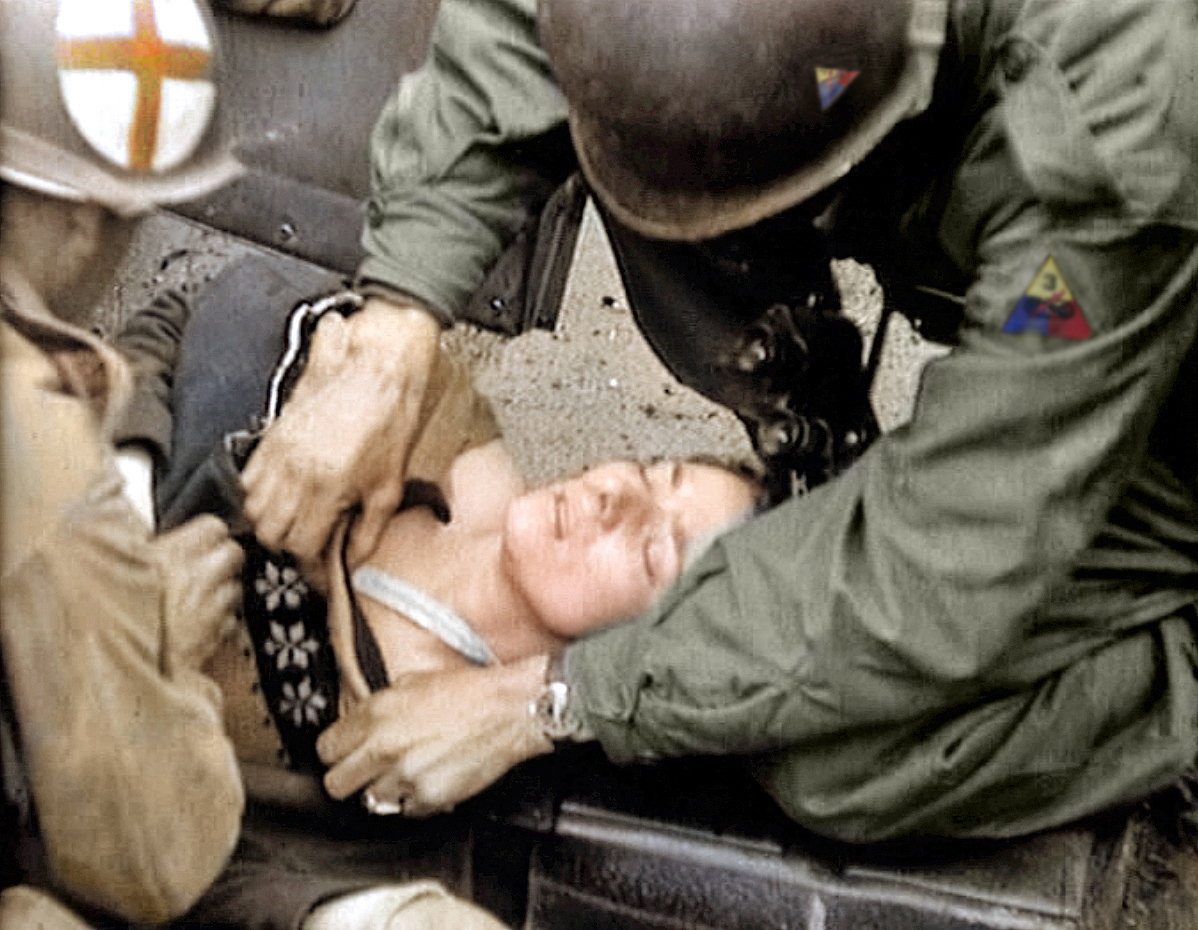
Katharina Esser
 | Here you can find a sub-page with a short version of this very detailed page here. |
The prehistory
Cologne, March 6, 1945. It is around 11:00 a.m. when the advancing US troops approach the Kaiser-Wilhelm-Ring and thus the inner city area, coming from the Subbelrather Straße via the Gladbacher Straße. Standing on Gladbacher Straße, they can already see across Kaiser-Wilhelm-Ring to Christophstraße (white arrow) and the church of St. Gereon (black arrow).

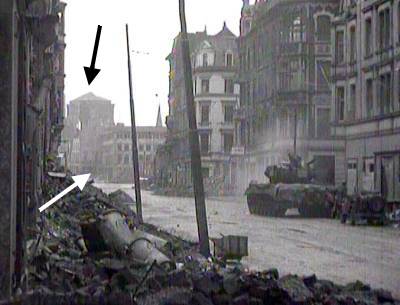
In the area of Christophstraße, a German Panzer IV is standing at this time and firing in the direction of the advancing US troops. This German tank was supposed to drive to the Gereon freight station, after it had come from the other side of the Rhine over the Hohenzollern bridge only in the morning. However, it is now already here, shortly before its actual destination, facing the advancing US troops.
The US troops are also firing across to the German side and in particular the German tank. Particularly involved is a Pershing-type tank whose 19-year-old gunner is a young man named Clarence Smoyer.
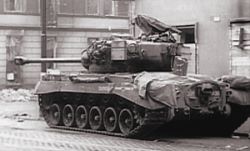
 The Pershing-type tank advancing with the troops. Still a fairly new tank model, it is the focus of interest for the cameramen advancing with the troops. In the case of the units on Gladbacher Straße, these are the film cameramen Jim Bates and Leon Rosenmann. Later in the day, they will be filming the famous tank duel at the cathedral. The Pershing-type tank advancing with the troops. Still a fairly new tank model, it is the focus of interest for the cameramen advancing with the troops. In the case of the units on Gladbacher Straße, these are the film cameramen Jim Bates and Leon Rosenmann. Later in the day, they will be filming the famous tank duel at the cathedral.
One of them uses the telephoto lens of his camera and films the side still in German hands in close-up. In the film images created in this situation, a person can be seen standing by a car on the opposite Christophstraße, i.e. on the - still - German side. This person is at the side, presumably at the slightly opened passenger door of the car and closes it at the end of the short scene. Possibly this car had been shot at and hit during the fighting (which is not visible in the film) and this person now wants to help the passengers in the car or has even been a passenger himself and then got out - the door on the other side - probably the driver's door - is wide open. So now the person possibly looks for a possibly existing occupant. However, the person closes the door. Using video editing software, I enlarge and edit a section of the original movie frame. The short video created can be viewed below:
A close-up shot of this car taken later, shows why the man probably closes the door again. 
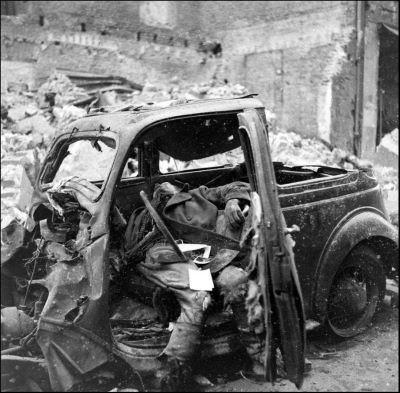
photo source: John Florea - LIFE Photo Collection
 The driver of the car is beyond help, lying dead in the driver's seat. The driver of the car is beyond help, lying dead in the driver's seat.
The vehicle had obviously come from the Dresden area, as the license plate visible on another picture reveals :
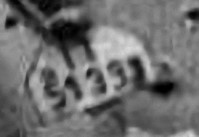
 The first two digits "II" stand for this regional assignment. It is also not a military but a private vehicle. The first two digits "II" stand for this regional assignment. It is also not a military but a private vehicle.
In the further temporal course (the above-mentioned man was now no longer at the car) a civilian car coming from the direction of Hansaring and entering the Christophstraße suddenly gets between the front lines during a filming. Clarence Smoyer, the Pershing's gunner, mistakes it for a military vehicle and immediately fires at it. The car is hit and rolls out to the side of Christopher Street. A short video of this film clip can be accessed below:
The driver of this civilian vehicle is shot in the head and dies instantly. He is accompanied in the car by a young woman. The latter is also so severely wounded in the course of the shelling that she is unable to flee from the car.
The following 3-picture sequence shows a shelling of the car by the US troops. The specific projectile can be easily identified by the tracer beam in the two left images (black arrows). In the rightmost picture it hits the car in the rear area (white arrow), possibly this is the hit that injures the young woman on the passenger seat 
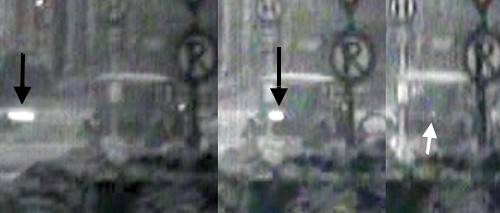
It cannot be excluded that at the same time the car came into the field of fire of the German Panzer IV and received an accidental hit from there. Gustav Schäfer, the machine gunner of Panzer IV at the time, who was interviewed on the DVD, does not consider it impossible that the car was also hit when it came between the fronts.
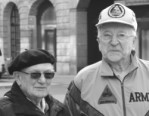
 The MG gunner of the Panzer IV, 18-year-old Gustav Schäfer (left), deceased in 2017, and the gunner of the Pershing, 19-year-old Clarence Smoyer, deceased in 2022, at a meeting in Cologne in 2013. The MG gunner of the Panzer IV, 18-year-old Gustav Schäfer (left), deceased in 2017, and the gunner of the Pershing, 19-year-old Clarence Smoyer, deceased in 2022, at a meeting in Cologne in 2013.
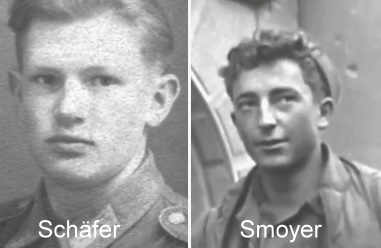
 The two shooters in wartime. Source: Adam Makos The two shooters in wartime. Source: Adam Makos
In any case, the fighting continues even after the car has been fired upon. The car is in the middle of the fronts the entire time, in the middle of the bullets flying around.

 The film images show that the passenger door is open. At this point, the young woman is obviously still sitting in the car, right next to the dead driver, because the body is not - as will be seen in the later shots (right image) - lying below the open door. This can be seen well on the left picture. The film images show that the passenger door is open. At this point, the young woman is obviously still sitting in the car, right next to the dead driver, because the body is not - as will be seen in the later shots (right image) - lying below the open door. This can be seen well on the left picture.
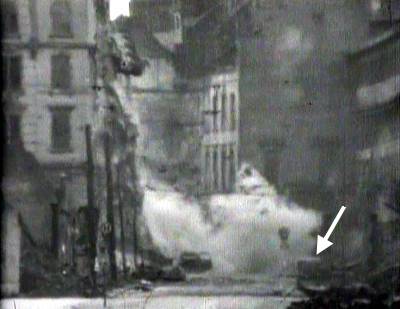
 The US troops let their lead tank, the Pershing, shoot at the house fronts of Christophstraße in order to hit or bury the German Panzer IV. The young woman's car is still parked on the right side of the street (white arrow) during this fighting or shelling by the US troops. The turret of the Panzer IV can no longer be turned correctly due to the falling debris from the shelled houses. The commander decides that the tank will withdraw. Its radio operator Gustav Schäfer reports to me that the tank did not go far for this. Together with the commander he then left the tank and hides in a cellar. He remembers to have read the writing "Hotel Gereon" on a house. From these descriptions one can draw the conclusion that he left the tank in Probsteigasse (at the corner of which there was still a Hotel Gereon in more recent times), about 100 to 150 meters behind the last firing position. The remaining crew, however, apparently continues with the tank. When Schäfer later comes to the street, the Panzer IV is no longer there. The US troops let their lead tank, the Pershing, shoot at the house fronts of Christophstraße in order to hit or bury the German Panzer IV. The young woman's car is still parked on the right side of the street (white arrow) during this fighting or shelling by the US troops. The turret of the Panzer IV can no longer be turned correctly due to the falling debris from the shelled houses. The commander decides that the tank will withdraw. Its radio operator Gustav Schäfer reports to me that the tank did not go far for this. Together with the commander he then left the tank and hides in a cellar. He remembers to have read the writing "Hotel Gereon" on a house. From these descriptions one can draw the conclusion that he left the tank in Probsteigasse (at the corner of which there was still a Hotel Gereon in more recent times), about 100 to 150 meters behind the last firing position. The remaining crew, however, apparently continues with the tank. When Schäfer later comes to the street, the Panzer IV is no longer there.
In another close-up, a passerby can be seen crossing street Von-Werth-Straße. He, too, is fired upon directly by the US troops, but is apparently able to reach the other side of the street unharmed. This film clip can be viewed below.
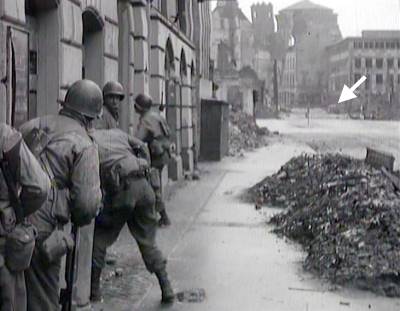
 The soldiers slowly advance to street Kaiser-Wilhelm-Ring. In the background, standing in Christophstraße, is the car of the injured young woman. The soldiers slowly advance to street Kaiser-Wilhelm-Ring. In the background, standing in Christophstraße, is the car of the injured young woman.
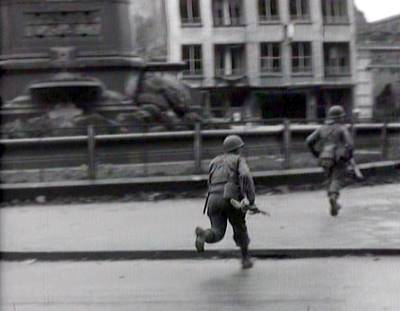
 At the fountain, the soldiers finally cross Kaiser-Wilhelm-Ring. At the fountain, the soldiers finally cross Kaiser-Wilhelm-Ring.
Only about an hour after the shelling of the car shown in the film, the US troops have advanced along Kaiser-Wilhelm-Ring to Christophstraße and finally reach the car still standing on the right side of the road. The woman is lying next to the car and is now being examined by an army medic 
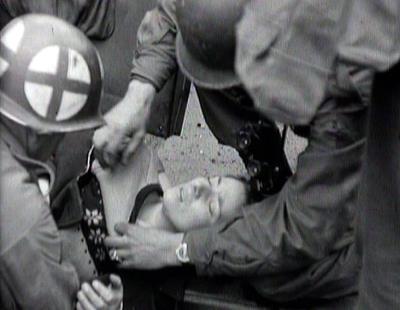
 The woman as she lies on the ground next to the car. The woman as she lies on the ground next to the car.
On the film images, various hits on the rear of the
car can be seen. 
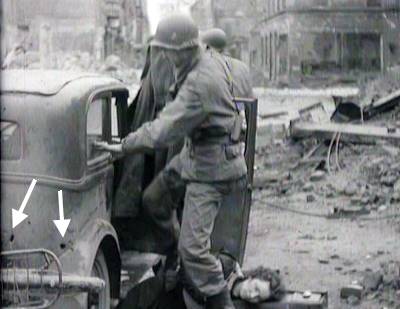
 Marked with arrows the bullet holes. Marked with arrows the bullet holes.
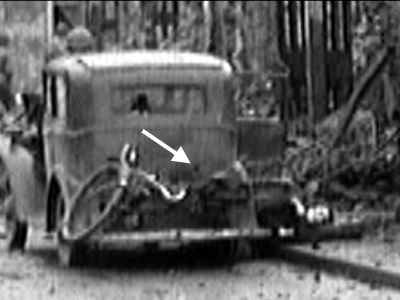
 And here marked with arrow the bullet hole caused by the hit shown further above. And here marked with arrow the bullet hole caused by the hit shown further above.
A photograph of the driver's side of the car shows the dead driver of the car 
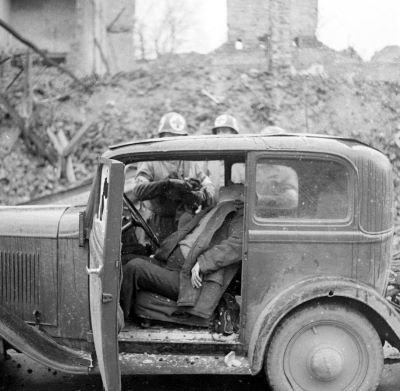
source: John Florea - LIFE Photo Collection
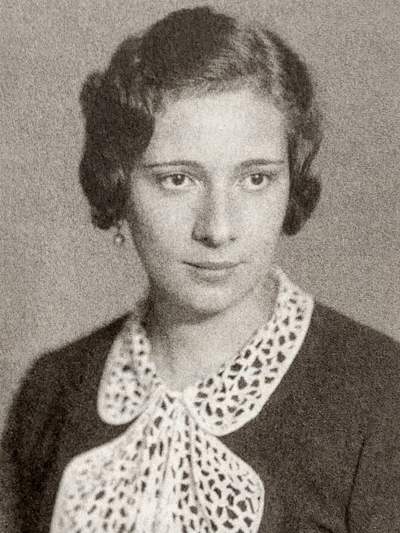
source Adam Makos |
|  After some research and a corresponding call for help in a Cologne daily newspaper, the Cologne journalist Hermann Rheindorf found out that this young woman was the 26 year old Katharina Esser from Cologne and presents some more background information about her and her fate on his DVD "Köln 1945 Nahaufnahmen". However, we will not go into this further background information here. After some research and a corresponding call for help in a Cologne daily newspaper, the Cologne journalist Hermann Rheindorf found out that this young woman was the 26 year old Katharina Esser from Cologne and presents some more background information about her and her fate on his DVD "Köln 1945 Nahaufnahmen". However, we will not go into this further background information here. |
On the DVD it is also shown in the following that the young woman in the further course of the events after the apparent calming of the situation in the context of a sudden nevertheless again flaring up combat situation (attack on the US troops with a bazooka out of a house) was accidentally rolled over and killed by an US tank. Whether this actually happened will be a topic on this page later.
But instead of being satisfied with this cruel realization, which is already seen on its own, Rheindorf goes a bit further in his documentary. On the DVD a film clip is shown, which shows a mangled corpse lying on Christophstraße, here a still of this scene 
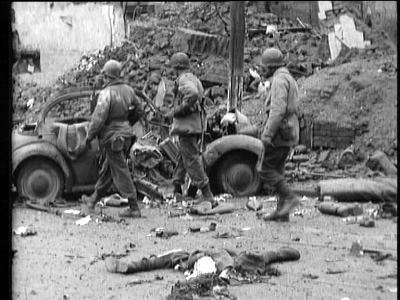
The question
It becomes almost touching when Rheindorf asks the audience whether the mutilated corpse that can be seen there is Katharina Esser, whereby he also confidentially calls Katharina Esser "Kathi" Esser ("Kathi" is a chummy shortening of "Katharina"):
"The thought that one of these corpses could be Kathi Esser does not only leave me with a queasy feeling"
Commentary from the DVD "Köln 1945 Nahaufnahmen" (Cologne 1945 close-ups)
Is it really necessary that in a film documentary one must now absolutely assign torn up body parts to a certain person ? Who should benefit from this ? Should the surviving relatives be able to look at a "very last photo" of "Kathi" ?
Then he asks an expert, a former head of a criminal investigation department (who had already been asked by Rheindorf about the cable theory (but had come to a wrong result there), whether this corpse is the young woman Katharina.
In view of the soldier's clothing of the corpse parts still striking despite tearing the expert comes however already after short examination to the - also in my opinion correct - result that it cannot be the young woman whose body is to be seen there torn on the street lying.
If one looks at the relevant entire section of the DVD on the subject Katharina Esser once completely exactly, the question forces itself already early whether this concrete question Rheindorfs "Is this corpse Katharina Esser ?" and the accomplished analysis of the former criminal policeman was also only in the remotest at all necessary or meaningful.
The car
First of all, the vehicle in the background of the still picture from the film shot at that time is not the car where Katharina Esser was sitting in. Her car is on the opposite side of Christophstraße and a little further back in the direction of Kaiser-Wilhelm-Ring / Gladbacher Straße. Esser's car is - as you can see on the film pictures - undamaged except for the smaller bullet hits. This car here is almost completely destroyed.
At this time, there are a total of 3 cars or wrecked cars (white arrows) in this section of the street.

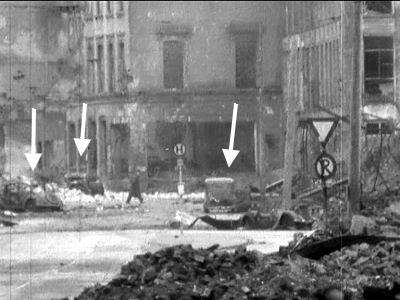
 This street area seen again from the direction of Gladbacher Straße into town, when the US troops had not yet fought their way there. The car on the far left is the one in front of which the body parts are lying in the photo above. Also at this time already more a wreck than a car. Further behind it another vehicle can be seen, this is the one on which the man standing next to it in the film shot was standing at the passenger door and the driver was lying dead on the driver's seat. The car of Katharina Esser is already on the right side of the street. Here to see also the further above already described person who recklessly crosses the street on foot and is shot at. This street area seen again from the direction of Gladbacher Straße into town, when the US troops had not yet fought their way there. The car on the far left is the one in front of which the body parts are lying in the photo above. Also at this time already more a wreck than a car. Further behind it another vehicle can be seen, this is the one on which the man standing next to it in the film shot was standing at the passenger door and the driver was lying dead on the driver's seat. The car of Katharina Esser is already on the right side of the street. Here to see also the further above already described person who recklessly crosses the street on foot and is shot at.
Gustav Schäfer, the crew member of the German Panzer IV, which was there at that time, later reports that at that time cars were constantly passing by in this area when he was standing there.
For these three cars now standing there, their journey did not end well.
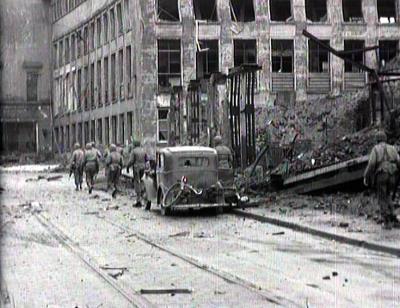
 The car of Katharina Esser, she is lying here on the ground to the right of the car. The cameraman has the Kaiser-Wilhelm-Ring in his back and stands filming in the direction of the city center / church St. Gereon. A short distance further into the city, behind the crossing Von-Werth-Straße, there is another car, it is the car described above, next to which the man was standing in the film clip and in which the dead driver is lying. If you have seen the close-up of the car above, you can also see here the two legs of the dead man sticking out of the car. The car of Katharina Esser, she is lying here on the ground to the right of the car. The cameraman has the Kaiser-Wilhelm-Ring in his back and stands filming in the direction of the city center / church St. Gereon. A short distance further into the city, behind the crossing Von-Werth-Straße, there is another car, it is the car described above, next to which the man was standing in the film clip and in which the dead driver is lying. If you have seen the close-up of the car above, you can also see here the two legs of the dead man sticking out of the car. 
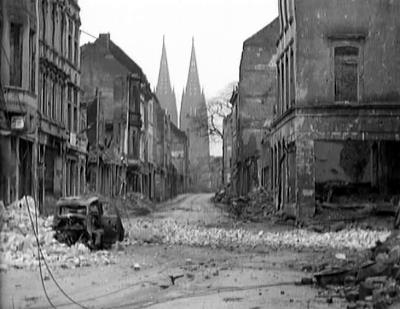
 The corresponding film shot was taken approximately from the position where the car of Katharina Esser was standing. Visible also debris on the street, which had fallen on the street after the shelling of the house fronts there by the Pershing. The corresponding film shot was taken approximately from the position where the car of Katharina Esser was standing. Visible also debris on the street, which had fallen on the street after the shelling of the house fronts there by the Pershing.
If one goes a little further in the direction of the cathedral already visible in the background and turns around, one has the following view back in the direction of Gladbacher Straße / Kaiser-Wilhelm-Ring 
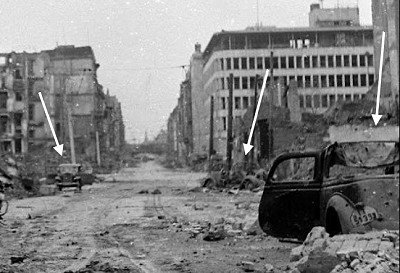
source: John Florea - LIFE Photo Collection
 On the right you can see the car from the previous picture in the foreground and behind it the destroyed car with the (here, however, hardly visible) body parts in front of it. On the left side of the street the car of Katharina Esser (all cars marked with arrows). On the right you can see the car from the previous picture in the foreground and behind it the destroyed car with the (here, however, hardly visible) body parts in front of it. On the left side of the street the car of Katharina Esser (all cars marked with arrows).
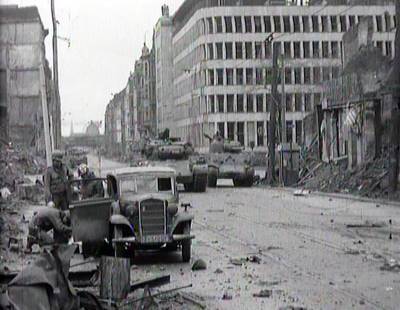
 Closer view from the front of the Esser's car. Closer view from the front of the Esser's car.
Here on this picture the Pershing is still in the background.
Very nice to see on this picture, by the way, that Esser's car was a civilian vehicle. The license plate is not a military one but a private one:

 The first two digits "1Z" stand for "Rheinprovinz" (rhine area). This is followed by a red angle, which means that the car was allowed to drive at all at that time when fuel was scarce. The first two digits "1Z" stand for "Rheinprovinz" (rhine area). This is followed by a red angle, which means that the car was allowed to drive at all at that time when fuel was scarce.
Below is an aerial view of this area, but taken at a completely different time, there is no debris in the streets 
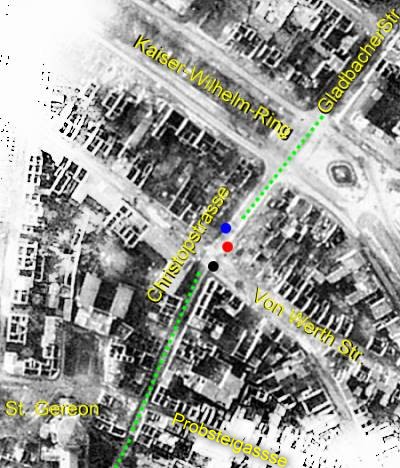
 The positions of the three cars in Christophstraße on March 6, 1945 are marked: blue dot - the car of Katharina Esser, red dot the destroyed car with the body parts in front of it, black dot the third car with the dead driver, already positioned a bit further in the direction of St. Gereon church. The positions of the three cars in Christophstraße on March 6, 1945 are marked: blue dot - the car of Katharina Esser, red dot the destroyed car with the body parts in front of it, black dot the third car with the dead driver, already positioned a bit further in the direction of St. Gereon church.
Again back to the body parts. The still image from the film already shown above, which is used as the basis for the analysis, may actually already show the correct assignment of the body parts to the correct car.


 The car looks like it was destroyed by an explosion and the body parts could have come from a person who was thrown out of the car through the door and torn apart in the explosion. The car looks like it was destroyed by an explosion and the body parts could have come from a person who was thrown out of the car through the door and torn apart in the explosion.
A total of two badly mangled body parts can be seen in the photos and footage of this area of the street. The body from the film footage (still image above), moreover you can see another body part in a photo also taken there at that time 
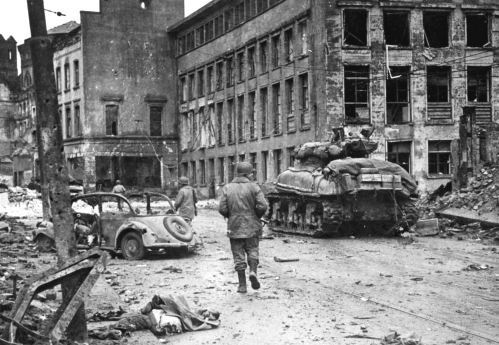
 Here in the foreground on the left side of the road is another mangled body part. It has a certain similarity with the body part seen on the other picture. So is it the same body part, which has only been pulled away from the middle of the road to the roadside in the meantime ? Here in the foreground on the left side of the road is another mangled body part. It has a certain similarity with the body part seen on the other picture. So is it the same body part, which has only been pulled away from the middle of the road to the roadside in the meantime ?
In the background one sees on this photo behind the soldier walking directly in front on the road just still something on the road lying. This could be from the position on the street and in relation to the car on the still picture quite also the other body part from the still picture from the film, here in particular the boot 
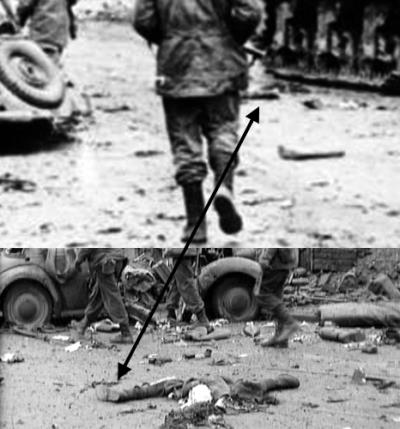
Also on the still from the movie something can be seen in the background, which could well be the other torn body part (left arrow) 
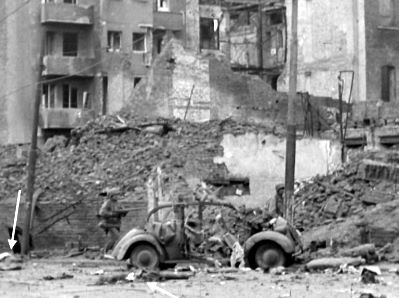
 So the probability is very high that these are two different body parts. Possibly these two body parts also belong to the same killed person ? However, on the film pictures at the car also at least another boot is to be seen lying on the street ... So the probability is very high that these are two different body parts. Possibly these two body parts also belong to the same killed person ? However, on the film pictures at the car also at least another boot is to be seen lying on the street ... 

 ... (directly to the right of the feet of the right of the three soldiers to be seen), so that some speaks for the fact that it will rather be about remains of at least two persons who have sat in the exploded car. ... (directly to the right of the feet of the right of the three soldiers to be seen), so that some speaks for the fact that it will rather be about remains of at least two persons who have sat in the exploded car.
The cameraman
Rheindorf himself then gives an excellent opportunity to prove the absurdity of his own question.
The pictures with the mangled body parts are obviously shot by a film cameraman (i.e. Bates or Rosenmann) at the scene of the event, while Katharina Esser is still lying next to her car and is being treated.
According to the explicit presentation on the Rheindorf DVD, the allegedly suddenly resurgent fighting, in the course of which Katharina Esser is run over and killed, occurs only after the cameramen have long since left the scene. When showing the film images from Christophstraße, Rheindorf comments as follows:
"What happened ... after these presumably last shots ? The cameramen continued to advance towards the cathedral, always close to Clarence Smoyer's Pershing tank"
Comment from DVD "Köln 1945 Nahaufnahmen" (Cologne 1945 Close-ups)
But if the cameramen were already away to the cathedral when the fighting flared up again, how should these cameramen have been able to take the shots of a Katharina Esser who had already been run over???
The location
And independent of the previously described impossibility that it was Katharina Esser's body parts. Katharina Esser lay - as one can see very well in the film - on the side of her car facing away from the road, thus quasi on the sidewalk.
If a tank rolled over her there, how should she have come to the other side of the street as a run over mangled corpse ?
Body parts there much earlier ?
On the film pictures, which were still made with telephoto lens from Gladbacher Straße, before the US troops crossed Kaiser-Wilhelm-Ring and came to Christophstraße, I look for further clues to the body parts filmed in Christophstraße. Two film clips stand out.
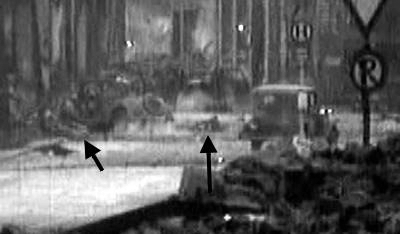
 Here on this still from the film, Katharina Esser's car is just entering the street area, being shot at. On the street around the destroyed car on the left side of the street something can be seen, which could well be injured or dead persons or parts of persons, thus in view of the situation also these body parts to be seen later in the film could be (arrows), the object arrow on the right seems thereby however here still quite large. Here on this still from the film, Katharina Esser's car is just entering the street area, being shot at. On the street around the destroyed car on the left side of the street something can be seen, which could well be injured or dead persons or parts of persons, thus in view of the situation also these body parts to be seen later in the film could be (arrows), the object arrow on the right seems thereby however here still quite large.
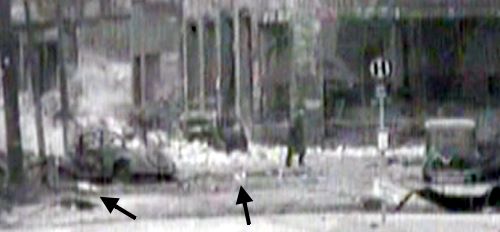
 And here another still of the shots, where the person runs over the street (and is also shot at by the US troops). And here another still of the shots, where the person runs over the street (and is also shot at by the US troops).
This scene was taken after the one from above. The car of Katharina Esser is now already on the right side of the road. Again, these two objects can be seen (arrows). The object on the right, however, doesn't seem so big anymore, it could be the same size as the part of the corpse in front of the car, which is filmed in more detail later.
The apparently reduced size of the object could be due to the fact that it was hit during the ongoing shelling of this street by the US troops and was further shredded / reduced in size. In the close-up footage, you can see some impacts of munitions on the road surface.
Quintessence
One will not be able to say it one hundred percent anymore, but the probability seems quite high that these objects lying on the road, which can be seen in the telephoto close-ups, are already the body parts of one or more soldiers, which had been thrown out and shredded by the explosion of the car standing on the left side of the road. And this already at a time when the car of Katharina Esser had not arrived there yet.
In this case, the body parts shown could not be Katharina Esser for this reason alone.
But even if one could not identify the objects on the street, which were still visible in the film pictures taken from Gladbacher Straße, as body parts, these body parts were already there, when the film cameramen were still at the place of the event, filmed it and at the same time Katharina Esser was visibly still alive.
Since, according to Rheindorf's own account, the cameramen had already left when the fighting unexpectedly flared up again, the film images cannot show a shredded corpse of Katharina Esser.
Questioning and analysis on the DVD on the subject of whether the body parts came from Katharina Esser were really completely superfluous after all.
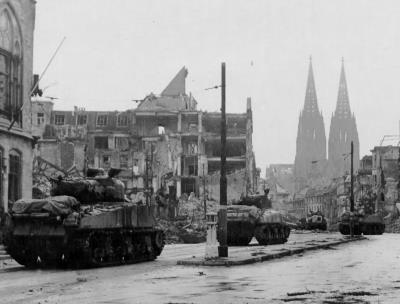
 After the troops have passed Christophstraße, they continue in the direction of the cathedral. Here a view over the Gereonstraße following the Christophstraße. After the troops have passed Christophstraße, they continue in the direction of the cathedral. Here a view over the Gereonstraße following the Christophstraße.
Here especially the Pershing will still play an important role in the famous tank duel at the cathedral.
Update 2014
Hermann Rheindorf follows up. In November 2014 a book about the events on March 6, 1945 and a new DVD, the so-called "Köln 1945 Nahaufnahmen - Edition 2015", i.e. a new edition of the old DVD from 2008 and another documentary called "Die tatsächlichen Bilder des Panzerduells am Dom" (the real pictures of the tank duel at the cathedral) will be released. In both documentaries Rheindorf introduces new information and statements and also drops old information and statements that were not tenable. In many cases, he also introduces additional arguments that are intended to further substantiate already existing views.
The chapter on Katharina Esser is still included in the 2015 edition, but Rheindorf has removed the sequences I criticized above with the question of whether the visible body parts could have come from Katharina Esser.
And how did Katharina Esser really die ?
According to Rheindorf's theory in the book and film, the US troops were suddenly shot at from a house by hidden German soldiers with a bazooka at this point, when the situation actually seemed to have been cleared up, the first tanks had passed through, the cameramen had already left and Esser was still waiting for further treatment. In the general panic of the soldiers, she had then been run over by an US tank.
Here, one must first understand why this depiction of later re-emerging battles occurs.
On the film pictures of the American cameramen we only see that first the car is shot at and later the American troops pass the car, with tanks and with infantrymen. At this time, Katharina Esser is lying badly injured on the passenger side of the car. Then the cameramen move on with the tanks and infantrymen along Gereonstraße towards the cathedral, everything well documented on film. What happens to Katharina Esser then is not shown in the film.
Now there is an affidavit of an alleged witness from the year 1946, in which it is written wordlessly that the woman from the car, Katharina Esser, had been run over by a tank.
This does not fit to the film pictures, but these few words of the witness are the basis of all further theses of Rheindorf.
Because it is clear, the American units moved on towards the cathedral and Esser was to be seen alive on the last film pictures.
So how does it fit together that according to the affidavit she should have been run over by a tank ?
And since we last saw them alive in the film, this very theory is put into the world that there must have been new fights and in the course of which a panicked tank crew is said to have rolled over Esser ...
Because that must have happened after the opinion of Rheindorf in such a way, if Esser should have been run over again by a tank after the film recordings, on which she nevertheless still alive in an obviously already pacified seeming situation, in which the US troops had already moved past. How should it work then differently ?
And so Rheindorf is desperately looking for information that could support the thesis that Katharina Esser was indeed run over by a tank in the end. It is a foregone conclusion that she has been run over, now all that remains is to gather some evidence.
Well, right away, there is no valid definitive proof of this sequence of events. There is no report, which represents this expiry in such a way. As in other places of his documentation Rheindorf again considers single events or documents and then constructs a certain sequence by skillful joining of information and disregard of facts speaking against it, which apparently simply leads to the solution desired by him.
However, since I know how Rheindorf deals with facts and sometimes does not handle them quite correctly, I will take a closer look at the circumstantial evidence he presents in the following. Rheindorf addresses the issue both in his film documentary and in his book.
Affidavit of an alleged witness
The most important piece of evidence for Rheindorf is an affidavit by a witness taken before the police 10 months after the events in January 1946, which is shown in the book and the film. In it, she writes in bad German language ... :
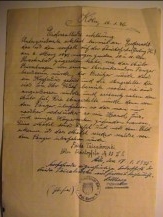
source: Rheindorf, 1945 Kriegsende in Köln |
|  ".. that I personally watched the incident on Christophstr. (Gerling H) on March 6, 1945 morning between 10 u. 11 o'clock, how the car private car was shot at by an American tank, the owner was killed by a head shot and the employee, who was trying to look after her boss, whereby she was also shot at and fell down sideways next to the car. The employee was then run over by the tank so that afterwards only remains as well as hand, foot and some body remains were to be found, I recognize the girl who was run over by the tank." ".. that I personally watched the incident on Christophstr. (Gerling H) on March 6, 1945 morning between 10 u. 11 o'clock, how the car private car was shot at by an American tank, the owner was killed by a head shot and the employee, who was trying to look after her boss, whereby she was also shot at and fell down sideways next to the car. The employee was then run over by the tank so that afterwards only remains as well as hand, foot and some body remains were to be found, I recognize the girl who was run over by the tank."
|
The description does not seem very convincing to me as a whole. Esser was run over afterwards by "the tank", which had already fired at the car before ?
Here easily 1 - 2 hours time are skipped, which are between 10 and 11 o'clock (firing at the car) and at least some time after 12 o'clock (filming Esser next to car) , where Esser was still alive. The witness also did not speak of a sudden tumult due to a later German shelling.
It is also questionable from where the witness wants to have seen all this. Was she standing comfortably on the side of the road or looking out of a window when the shooting between US troops and German tank took place ? There also adjacent houses were fired at and hit. The German tank was engaged in a battle with Smoyer's tank when Esser's car drove into the area. There the witness was not in cover or in a house cellar but observed in the midst of the firefight everything, also the drive of Esser's car ? And already according to the own statement of the shooter Gustav Schäfer, he had shot on the German side also in the direction of the US troops and probably also hit the car of the Essers during the approach. The witness does not say anything about this either.
In the affidavit she stated that she lived at Christophstraße 22, a little further behind the place of the incident in the direction of the St. Gereon church. On March 6, 1945, the German tank would have stood quasi directly in front of her house and fired in the direction of the US troops when the Esser's car had turned into Christophstraße and was fired at from both sides. In this respect it is quite strange that the witness only writes that the car was fired at by an US tank.
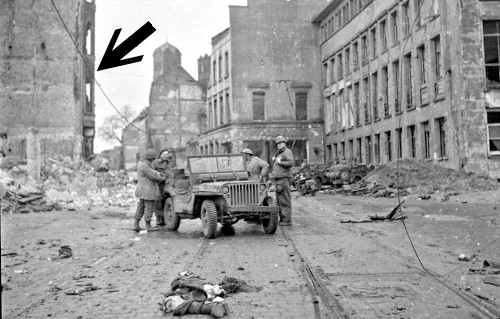
 source: John Florea - LIFE Photo Collection source: John Florea - LIFE Photo Collection
View from the area on Christophstraße where the shot down cars are standing, in the foreground remains of the German soldier that we had already seen above. The house Christophstraße 22, where the witness lived, was behind these houses on the left side of the street (arrow). At least from a window of the house the witness could not have seen properly into the street area at that time.
Also on film recordings during the supply of Esser by US soldiers no civilians are to be seen.
The witness also makes it sound as if Esser was run over next to the car. But next to the car, on the side where Esser lay, there were already directly rubble plots. How should at all on this narrow piece of sidewalk a tank can drive past ?

 Hardly place at the side of the car, how should find there a tank place and why ? The tank would drive on rubble / debris, thus also become worse maneuverable and moreover even in the case of a sudden fire also not in very much better cover, because the houses there were destroyed ... Hardly place at the side of the car, how should find there a tank place and why ? The tank would drive on rubble / debris, thus also become worse maneuverable and moreover even in the case of a sudden fire also not in very much better cover, because the houses there were destroyed ...
Also one sees on a photo, which must have been made obviously very many later after passage of the US troops, spatially unchanged the car of the Esser still with opened doors.
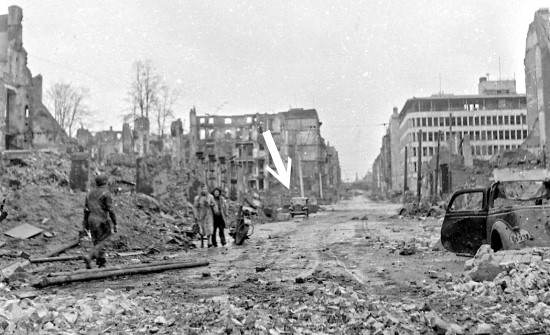
 source: John Florea - LIFE Photo Collection source: John Florea - LIFE Photo Collection
No traces of the destruction of the car (arrow) by a tank, which would have passed there on the footpath, where Esser lay, and surely would have rammed the car. Why the photo must have been taken much later ? Well, in the background, towards Gladbacher Straße, no more tanks can be seen heading towards the city center. Therefore, the photo seems to have been taken so late that an alleged attack on the US troops at this place must have been already over - for lack of potential targets ...
You can't see a shot down tank standing there either !
And Katharina Esser is not lying next to the car anymore ! The door is open, the car (according to comparisons with pictures, when she was still lying there) still unmoved at exactly the same place. It is very unlikely that a tank would have rolled over the Esser lying next to the car in such a way that neither the door of the car would have been torn off, nor the car would have been shifted somehow, if at the same time by rolling over Katharina Esser from head to foot only body remains should have remained. A damage or a displacement of the car would have been actually completely unavoidable.
Rheindorf himself shows in the book also a photo from that time when the photo above was taken. It also shows the two ladies at this location, only 1 or 2 minutes after the picture taken above. In the background the Esser's car. Rheindorf also writes, as I do here, that this is a later picture, in which the car "appears to be seen untouched in the background." So Rheindorf also assumes that Esser would still have been lying next to the car when she was run over and the car would also have been damaged by this. According to Rheindorf, Esser must have been lying next to the car at this moment of the photo, because it was apparently undamaged. And in the book he also explains in the following of the photo, why it should have come quasi afterwards to this photo still to the sudden renewed fight situation. Actually he has contradicted himself with it, because ...
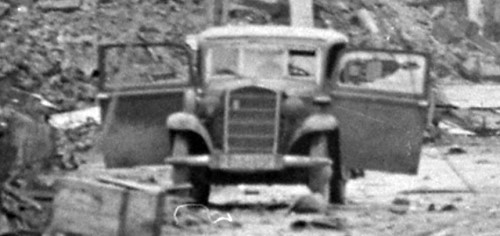
 source: John Florea - LIFE Photo Collection source: John Florea - LIFE Photo Collection
The car again at the same later time, only in an enlargement of another picture from these same minutes (the photographer John Florea had taken several photos in the street in these minutes). Esser, as I said, is no longer lying next to the car !
Of course Rheindorf did not mention this in his book about this photo ! He writes indirectly only that the car is not damaged here yet and therefore Esser could have been run over beside the car only afterwards.
The story that Esser fell out of the car and was run over by a tank next to it cannot be true.
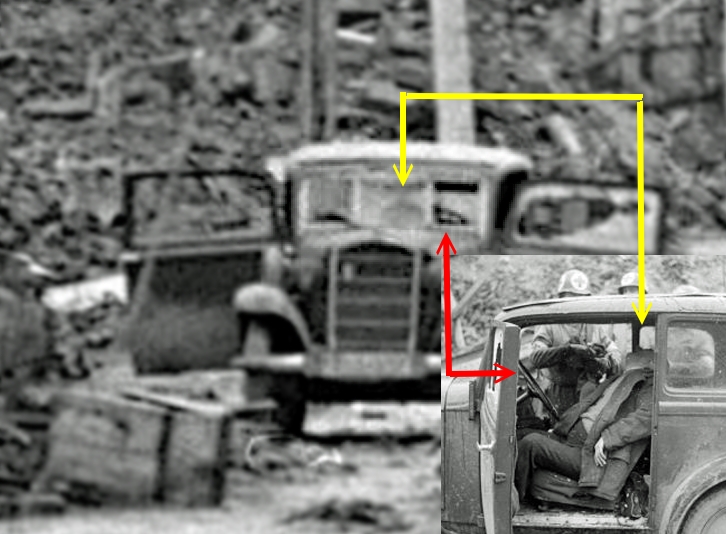
 source: John Florea - LIFE Photo Collection source: John Florea - LIFE Photo Collection
And something else stands out when you take a closer look at the picture. As noted above, Katharina Esser is no longer lying next to the car here. But the driver, her boss Delling ...
... is still sitting dead on the driver's seat !
He is sitting slightly tilted to the side towards the passenger seat. The comparison with the other picture from above shows it clearly. Delling and the steering wheel are clearly visible through the windshield.
Katharina Esser was obviously taken away from the car, the dead Delling was left in the car ...
But before we come back to the affidavit in more depth later, let's first look at the other "evidence" Rheindorf presents to support the thesis that Esser was run over by a tank....
The allegedly shot down Sherman
Rheindorf shows in his book as further alleged proof also the picture from further above, on which a tank stands at the crossing behind Esser's car:

 Rheindorf writes about it: "The picture possibly shows the situation after the attack on the US troops with a bazooka. The Sherman tank standing on the right is said to be a downed combat vehicle." Rheindorf writes about it: "The picture possibly shows the situation after the attack on the US troops with a bazooka. The Sherman tank standing on the right is said to be a downed combat vehicle."
Well, the picture from the archives "Bundesarchiv", listed under picture 146-1971-053-63, is there in the archives named "Sherman in front of destroyed building", in the historical U.S. original it says "Infantrymen and armor of the First U.S. Army proceed through the streets of war-battered Cologne. A body lies in the guttor at left.". So no indication that this is a downed tank. By the way, the tank is a so-called Sherman M4A1 DD, a variant of the Sherman tank that can also be used as a floating tank.
Why Rheindorf says it is a shot down combat vehicle is neither explained by the photo description nor by any other evidence shown in book or film, so maybe it is just wishful thinking for his theory ...
But I also search again for other pictures from this area to back up and find a photo of the US Signal Corps, which after years of research around the events of March 6, 1945 is certainly known Rheindorf and shows a row of US tanks on the advance later following Gereonstraße:
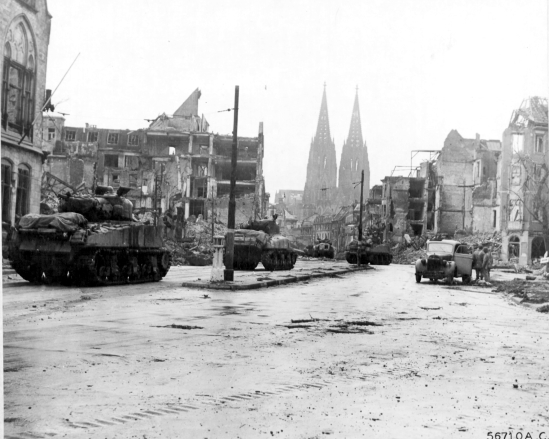
 And lo and behold, the tank, which according to Rheindorf should have been shot down before, drives there as the second from the left cheerfully in the column in the direction of the cathedral, the area at the Christophstraße had already passed the tanks. In his book hundreds of pictures of Cologne on this day are shown. Of all things, this picture from Gereonstraße, which shows the allegedly shot down Sherman and thus would disprove his proof, is not included ... hmmm ... And lo and behold, the tank, which according to Rheindorf should have been shot down before, drives there as the second from the left cheerfully in the column in the direction of the cathedral, the area at the Christophstraße had already passed the tanks. In his book hundreds of pictures of Cologne on this day are shown. Of all things, this picture from Gereonstraße, which shows the allegedly shot down Sherman and thus would disprove his proof, is not included ... hmmm ...

 The comparison of the two pictures is clear, it is a M4A1 DD, the arrangement of the boxes with ammunition on the rear of the tank is like a fingerprint and each tank has a different arrangement or color variations of the boxes at this day. These are actually identical. The comparison of the two pictures is clear, it is a M4A1 DD, the arrangement of the boxes with ammunition on the rear of the tank is like a fingerprint and each tank has a different arrangement or color variations of the boxes at this day. These are actually identical.
So this tank was definitely not shot down in Christophstraße...
The house from which the German soldiers were shooting
It is exciting to examine the different statements of Rheindorf, that he can't quite agree from where the German Panzerfaust attacker should have fired. In the book on page 134 there is talk about a "house directly at the Gereonstraße", in the film from a house in Christophstraße.
Nothing is shown, no photo, no report or other text is shown, where one can see / read this street name clearly and explicitly letter by letter. Text passages are shown, but they do not contain the street name. The street names are simply claimed, like it or lump it ... hmmm... not very trustworthy ...
The historian
Another alleged proof is also curious.
Rheindorf refers with regard to an bazooka firing of a Sherman in the film first to a corresponding treatise of an unknown historian, said to be treating a Sherman firing on Christophstraße. In addition he fades in a text passage, which allegedly originates from this treatise.
Also, the text shown does not mention that a woman was run over by a tank, although otherwise the dead of the incident on the German and American side are described in more detail.
And in the shown piece of text also the name of the exact place does not appear at all where all this is supposed to have happened. So the name of the street ? Did it happen at all in street Christophstraße (in Rheindorf's book it was allegedly Gereonstraße, where a Sherman is said to have been shot down) ? Again a strange evidence by Rheindorf.
Directly I am surprised that the allegedly relevant text passage predominantly takes up only a small part of the picture and also can not be seen completely - very strange. What is this ?
Moreover, I notice that the text shown mentions a time when a tank is supposed to have been shot down by a bazooka.
"The "Sherman" tank was shot down on the morning of 06.03 '45, around ..."
Yes, around ... ????
Time ... ????
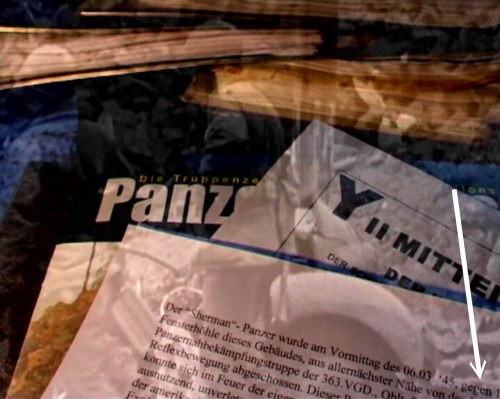
 From the film: the background takes up a lot of space compared to the decisive text. The time of the incident mentioned there, however, is almost "perfectly" cut off or not recognizable for the normal viewer of the film, the passage also slowly pans out of the picture. From the film: the background takes up a lot of space compared to the decisive text. The time of the incident mentioned there, however, is almost "perfectly" cut off or not recognizable for the normal viewer of the film, the passage also slowly pans out of the picture.
This makes me already suspicious after all my experiences with the documentation style of Rheindorf, particularly since also the word "morning" is contained in the text to the incident, thus actually a time BEFORE 12 o'clock.

 Documents, which are unrestrictedly harmless or even helpful for him or his theories (like the affidavit of the witness), he shows in the film mostly gladly well readable (screenshot from Rheindorf's film - to be seen in the book also completely). But as far as letters, books, documents are made difficult to read, especially in the film, by showing excerpts and "camera flights" over the document, where one can't really recognize or read the text in a hurry, it usually becomes adventurous with his rendering of the alleged content ... Documents, which are unrestrictedly harmless or even helpful for him or his theories (like the affidavit of the witness), he shows in the film mostly gladly well readable (screenshot from Rheindorf's film - to be seen in the book also completely). But as far as letters, books, documents are made difficult to read, especially in the film, by showing excerpts and "camera flights" over the document, where one can't really recognize or read the text in a hurry, it usually becomes adventurous with his rendering of the alleged content ...
So what did he possibly want to disguise by this strange presentation of the text ?
I look at frame by frame of the film sequence and shall be right with my skepticism.
In the first frame of this film sequence, a small piece of the time written in the document can actually be recognized during the insertion, before it disappears in the next frames very quickly from the visible area. The normal film viewer does not see this, so quickly is the area of the text in the normally running film already out of the picture again. But the enlargement shows it:
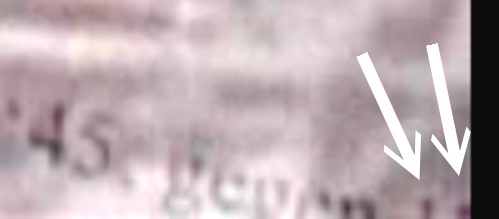
 Not easily recognizable, but the first number of the time is in any case a "1" and the second number, as it looks, must also be a "1". In any case, it is not a "2" ! Not easily recognizable, but the first number of the time is in any case a "1" and the second number, as it looks, must also be a "1". In any case, it is not a "2" !
With that, the time mentioned was not to be seen:
11 o'clock
So the normal movie viewer could not see this time. And it is not mentioned in the commentary of the film, of course.
Let us remember the soldier's watch in the film scene in which Katharina Esser is treated. Rheindorf himself had zoomed in on it in the documentary and found that it showed a few minutes after 12 noon, when Esser was being treated.
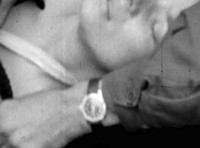
 "A few minutes after 12 o'clock" Rheindorf records in the commentary of this film scene ... "A few minutes after 12 o'clock" Rheindorf records in the commentary of this film scene ...
Thus the firing of a Sherman, to which Rheindorf refers here, was in reality 1 hour before the scenes showing the treatment of Esser on the ground next to the car ! The shooting described there could not have caused a panic situation in the Christophstraße, in which Esser would have been rolled over and at 11 o'clock there were no US tanks in the Christophstraße at all, because the US troops were still in the Gladbacher Straße on the other side of the Kaiser-Wilhelm-Ring at that time. So the firing of this Sherman must have happened somewhere else entirely. In every case not in Christophstraße.
Excitingly, this "piece of evidence" is also only shown in the film, where the defensive pointing technique can be used to hide the time. In the book this report of the historian is not mentioned at all. Of course, one would have to show a picture of the report and then one would be able to see the time or one would have to show only a small section of the report without the time and that would have been very conspicuous ... So you cover the time in the movie and you don't have to mention it in the book... A time that would not fit at all to what he wants to prove ...
And 11 o'clock is confirmed by another film clip. Rheindorf states that, elated by the above findings, he wrote to a newsletter of the US 3AD (which is also read by veterans), in order to perhaps be able to learn more details of a shooting down of a US tank there from the veterans who were in Cologne at the time. The letter he wrote is shown in the film, but reading it is made difficult by a camera flying over the paper in different directions. But again, a freeze frame then makes it clear after all...
So what does Rheindorf write to the US Army veterans at the time of the tank firing ?
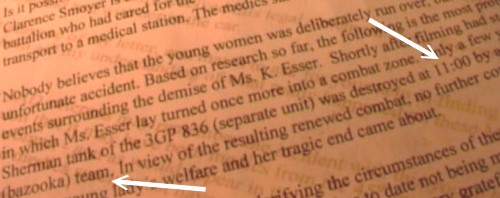
 He himself refers in his letter already directly to a firing expressly at 11 o'clock (right arrow) ! Not at 12 o'clock or later, when Esser still lay alive beside her car ! A firing at 11 o'clock could not have led to any analyzable result with regard to the allegedly after the film scene with Esser at 12 o'clock again flared up fight with firing of a tank and from it resulting overrunning of Esser? He himself refers in his letter already directly to a firing expressly at 11 o'clock (right arrow) ! Not at 12 o'clock or later, when Esser still lay alive beside her car ! A firing at 11 o'clock could not have led to any analyzable result with regard to the allegedly after the film scene with Esser at 12 o'clock again flared up fight with firing of a tank and from it resulting overrunning of Esser?
Was Rheindorf only interested in proving that some US tank had been shot down somewhere there at some time, in order to be able to claim the resulting overrunning of the Essers under concealment of the time, although this actually did not exist or could not be proved ?
In any case, even the evidence with the historian's account is not valid.
The veteran
Next, he mentions a letter he received from an US veteran as a reaction to his letter. In the film, the letter can again only be seen in part and therefore difficult to read as it flies through the frame. Rheindorf comments that the soldier had been "at this spot" and had been shot down !
Sounds like another supposedly convincing proof (the viewer of the film does not know the time difference and understands by "at this spot" of course the street section of Christophstraße, where Katharina Esser lay wounded.
So "at this spot" he was actually shot down ?
In the book, Rheindorf varies "at this spot." He writes that the veteran was shot down "in this area". The letter is also fully visible in a very small photo. The veteran describes in it indeed that his tank had been shot down by a Panzerfaust at noon on 6.3.1945. Following the text passages from the letter, which refer to localities in Cologne.
| "I know nothing of her (Katharina Esser) situation at that time. I am writing because I was a tank crewman in the city on that day.
I was a member of Company D ... and our tank was "knocked out" by a Panzerfaust about noon of that day. We had approached the city from Pulheim and through the airfield and went in among the city buildings.
A German soldier fired a Panzerfaust at us from the second floor of what I remember was an apartment house. The shell hit ... "
|
Where he was shot down, the veteran does not write at all !
.
He writes in summary only that he was in the city of Cologne on the road and had been shot down from a building with a bazooka. No reference to a specific location, a district, a street ... .
In the book Rheindorf goes one step further than in the film. There he writes under the photo of the veteran shown there:
| "... he is shot down and injured in the Gereonsviertel with his tank crew. ..."
|
Wow ! The veteran did not write that at all in his letter that he was in the area "Gereonsviertel" - in Englisch "Gereon's Quarter" - , this is how the region in this area of Cologne is called, referring to the church St. Gereon located there. But Rheindorf just pretends that the veteran said that and presents it as a fixed fact ! The Christophstraße, where the incident with Katharina Esser happened, is located in the "Gereonsviertel" - .
So Rheindorf cleverly suggests to the reader that the tank was shot down "there" and thus the story with the tank rolling over must be true because of a renewed combat situation !
Rheindorf only succinctly (but still) points out in the film that this soldier was traveling with D Company, which was "one house block" to the north from Smoyer's unit...
Hmmm, "one house block" away ... ???
So not traveling with Smoyer's unit on Christophstraße...
So did this soldier and his tank even pass Christophstraße ? And why should the unit go there at all, if it was already heading further north towards the city center before ?
And what is one house block distance in Cologne ?
Rheindorf himself quotes in the book a German soldier of the 363rd Volksgrenadier Division who was posted that morning in the Hansahochhaus (Hansa high-rise building) at street Hansaring. The soldier writes in a war diary that at noon US troops crossed "100 meters (0,06 miles) west of our high-rise building ... the street Hansaring ...".
Were the soldiers passing the ring perhaps the unit to which the soldier who had described the firing of his tank belonged ? The alleged "block of houses" to the north (i.e. in the direction of the Hansa high-rise) away from Christophstraße ?
Well, 100 m (0,06 miles) away from the high-rise building Hansa high-rise ?
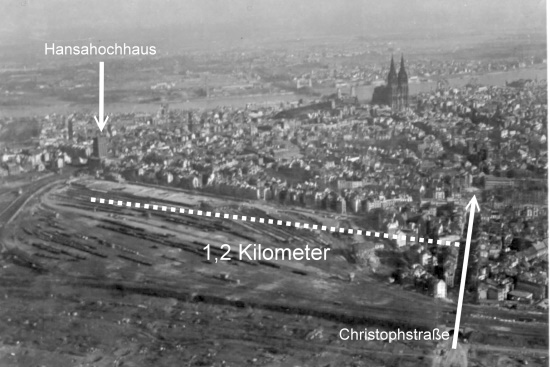
 source: NARA. For comparison, between the confluence to the Christophstraße from the Street Hansaring and the Hansa high rise is a distance of 1,2 kilometers (0,75 miles) ! Even if the described US troops would have been actually even 200 meters (0,12 miles) away from the high-rise building, this was still 1 kilometer (0,62 miles) away from Christophstraße. It does not seem realistic that these troops should have moved from there at the Hansaring even further to the Christophstraße. This would have been a route parallel to the city center and not a further advance towards the city center ... source: NARA. For comparison, between the confluence to the Christophstraße from the Street Hansaring and the Hansa high rise is a distance of 1,2 kilometers (0,75 miles) ! Even if the described US troops would have been actually even 200 meters (0,12 miles) away from the high-rise building, this was still 1 kilometer (0,62 miles) away from Christophstraße. It does not seem realistic that these troops should have moved from there at the Hansaring even further to the Christophstraße. This would have been a route parallel to the city center and not a further advance towards the city center ...
My findings are also supported by a map from the book "Spearhead in the West", which Rheindorf shows in the film, while at the same time he comments that he had received a letter from the soldier and that the soldier with his unit had been only one block away. In the book, this map is printed in faint gray as the background of the entire page with Rheindorf's corresponding comments.
This map, which contains English designations as well as handwritten annotation " ...into the city" was thus presumably copied by this soldier from the book and attached to his letter. The map contains a continuous colored marking of various streets, which starts from city of Pulheim along the airport Butzweiler Hof via city district Longerich towards the city center (the soldier also writes in his letter that he drove via the airfield).
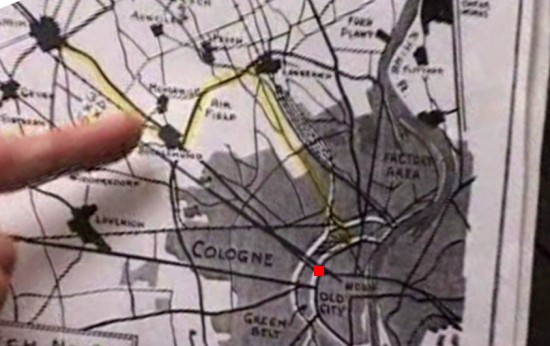
 The map obviously marks the route that D Company, in which the soldier was, had taken into the city. D Company was part of the so-called task force Kane, which consisted of the medium tank companies of the 1st battalion, 32nd armored regiment and always advanced on the city center a little farther north than task force Doan, in which Smoyer's tank was also driving. It becomes clear that the soldier had thus advanced from Pulheim via Longerich towards the city center and must have hit the street Hansaring in the area between Hansaring (with the above-mentioned Hansa high-rise) and today's square Ebertplatz, at this time called square Adolf Hitler-Platz. The marking on the map does not continue in the direction of Christophstraße but ends in the area between Hansaring and Ebertplatz, so that the soldier with his tank was probably shot down there, i.e. relatively far away from Christophstraße and Katharina Esser (red dot drawn by me). Of course, the different companies had to keep a certain distance from each other in order not to shoot at each other accidentally. Also for this reason the D Company should not have been too close to Smoyers's E Company. In any case, the firing of a tank in the distant D Company would not have caused any panic reaction among the troops in Christophstraße. The map obviously marks the route that D Company, in which the soldier was, had taken into the city. D Company was part of the so-called task force Kane, which consisted of the medium tank companies of the 1st battalion, 32nd armored regiment and always advanced on the city center a little farther north than task force Doan, in which Smoyer's tank was also driving. It becomes clear that the soldier had thus advanced from Pulheim via Longerich towards the city center and must have hit the street Hansaring in the area between Hansaring (with the above-mentioned Hansa high-rise) and today's square Ebertplatz, at this time called square Adolf Hitler-Platz. The marking on the map does not continue in the direction of Christophstraße but ends in the area between Hansaring and Ebertplatz, so that the soldier with his tank was probably shot down there, i.e. relatively far away from Christophstraße and Katharina Esser (red dot drawn by me). Of course, the different companies had to keep a certain distance from each other in order not to shoot at each other accidentally. Also for this reason the D Company should not have been too close to Smoyers's E Company. In any case, the firing of a tank in the distant D Company would not have caused any panic reaction among the troops in Christophstraße.
A final look at a US Army operational log also supports my assumption. In the military log, the reports of the various US units to their respective current locations were entered.
On an old map of the US Army I have entered as colored points the locations that were assigned to Taskforce Kane in the mission report. In addition to Company G, the said Company D also belonged to Taskforce Kane. Messages to the locations of the Taskforce Kane took place during the advance chronologically assigned as follows:
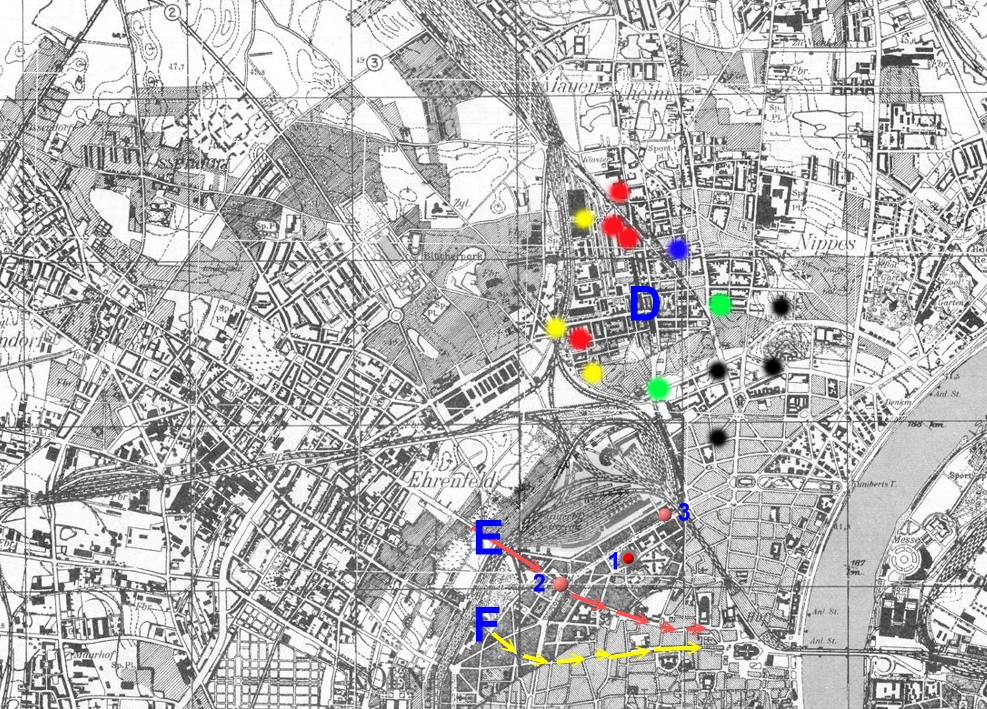
 The locations around the capital letter D for the D Company: 12:05 o'clock (yellow), 12:45 o'clock (red), 13:15 o'clock (blue), 14:20 o'clock (green) and 16:30 o'clock (black). All entries were thus made in the area of the Cologne-Nippes city district. It was obviously a tenacious advance of US troops in this area. The locations around the capital letter D for the D Company: 12:05 o'clock (yellow), 12:45 o'clock (red), 13:15 o'clock (blue), 14:20 o'clock (green) and 16:30 o'clock (black). All entries were thus made in the area of the Cologne-Nippes city district. It was obviously a tenacious advance of US troops in this area.
Here you can see that the D Company has never been in the area of Christophstraße and at the car of Katharina Esser (2) standing there in the relevant period, in which Katharina Esser is alleged to have been run over.
The Hansa high rise is marked with number (3). With number (1) a location is marked, at which at 14:20 o'clock units of the Taskforce Doan with the Company E had been reported. The latter suggests that it was therefore probably Company E units that had previously crossed the street Hansaring to the west of the Hansa high rise. This is what German soldiers had reported in the Hansa high rise at the time - as written above.
So the supposed proof with the veteran from D Company goes completely nowhere. It is even a particularly full-blown smoke candle and strictly speaking a deliberate falsification of facts. The Veteran and his tank were not at all near Katharina Esser's position when they were shot down. The veteran was shot down with absolute certainty in the district of Cologne-Nippes, about 2 - 3 km away from Christophstraße and thus Esser's position.
Rheindorf brazenly assigns this shooting down to Christophstraße with the local assignment "was in this area" and "Gereon's Quarter", which in truth he invented and only foisted on the veteran, although he had to know exactly the distant positions of D Company on the basis of the US Army documents. He knew that the veteran with D Company was never around, but portrays it that way in the film and book ...
Very brazen ...
Diary entry
According to Rheindorf's book, further evidence is provided by the report of a staff doctor, Künstle, who prepared a kind of division chronicle for the 363rd Volksgrenadier Division mentioned earlier. This division was on the move in various places in Cologne and had taken up quarters in the Hansa high-rise, among other places, on the night of March 6, 1945. Künstle writes - however without recognizable closer assignment to concrete localities and time of March 06 in Cologne - , that a tank destruction squad under Hptm. Rose had shot down two Shermans with a Panzerfaust in the context of heavy infantry fighting. Rheindorf simply claims in the book that this happened in Gereonstraße. However, Gereonstraße is not mentioned at all in the text excerpt shown. And as a reminder: at another point in his film, at the alleged evidence "the historian" (see above), it was supposedly Christophstraße where the shooting happened.
In the book "Geschichte der 363. Infanterie-Division" (Story of the 363.Infanterie-Division) by Helmut Golke this event is also mentioned. There, however, it is described in such a way that in the "afternoon a strong enemy group with tank support wanted to penetrate the last bridgehead and Hptm. Rose with quickly gathered men and bazookas succeeded in sealing off the penetration and in the process also shot down a tank. There, too, a specific location is not named.
Apart from the fact that there is disagreement about how many tanks were shot down, it does not seem realistic that these events happened in Christophstraße.
Because already around 12 o'clock Smoyer's tanks and other tanks had passed Christophstraße and were on their way to the cathedral. So here it was not at all a question of having sealed off an incursion into a last bridgehead. So the description does not fit at all to the events in Christophstraße, where the break-in of the US troops had happened already. In the areas further north of Christophstraße, for example in city district Cologne-Nippes, the US Army was still having problems with the advance into the city center. So there may have been a launch with the bazooka ... (see the veteran's story above).
But that was nowhere near the position of Katharina Esser.
Another thought shows how absurd the thesis is that from a house on Christophstraße a bazooka was fired at advancing troops. At the very front of the advancing troops, all houses were searched individually by infantrymen for resistance fighters. This was a time-consuming process that was documented many times in films and photos in Cologne and the area around Christophstraße. These house searches in this area are also briefly shown in the film images from Christophstraße. The houses were also searched in the side streets.
Thus, it is hardly conceivable that a squad of German soldiers with a bazooka should still have been in these houses in the area or could still get there afterwards. The area was already firmly in American hands, how should the German soldiers have been there or come there at all ?
The jeep
Another alleged proof of Rheindorf is another photo from the Christophstraße area, which Rheindorf shows in his book. It shows a jeep at the junction of Von-Werth-Straße and Christophstraße.
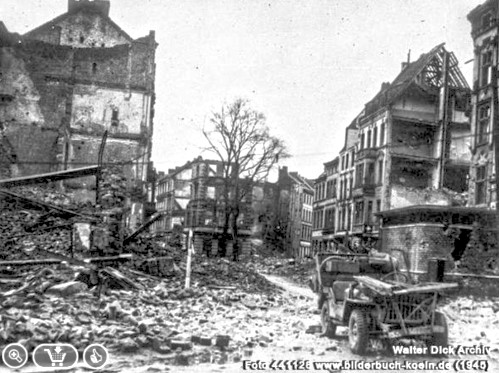
 Source of the same picture: Bilderbuch Köln. Rheindorf writes: "An US jeep damaged by shelling in the middle of the intersection Christophstraße / Von-Werth-Straße". The intention of this presentation of the picture is clear. There was indeed a battle there, the jeep was damaged during this incident ... Well, damaged by shelling ? Source of the same picture: Bilderbuch Köln. Rheindorf writes: "An US jeep damaged by shelling in the middle of the intersection Christophstraße / Von-Werth-Straße". The intention of this presentation of the picture is clear. There was indeed a battle there, the jeep was damaged during this incident ... Well, damaged by shelling ?
The jeep doesn't look like a tank drove over it in panic or crashed into it. If it was hit by a bazooka, the car would also look really destroyed. There are no destroyed parts of the jeep next to the car.
But the jeep indeed looks different from other US jeeps at first sight. Is that already the supposed "damage", that it looks different ?
A little research shows. There are Jeeps that look like this, it is a kind of transport Jeep
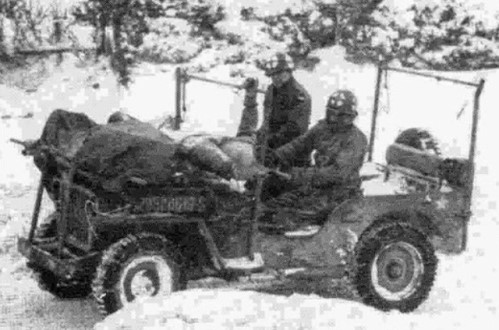
 source 324th Medical BattalionUnit History. In the front area of these jeeps is a rack on which items could be transported. The jeep was also used by medical units, for example. The photo shows such a use. source 324th Medical BattalionUnit History. In the front area of these jeeps is a rack on which items could be transported. The jeep was also used by medical units, for example. The photo shows such a use.
And the jeep on the photo looks very similar to the jeep in Cologne, the attached rack can be seen clearly. The Jeep has lighter damage in the front bumper area, but this probably represents more normal wear and tear. The jeeps certainly had plenty to do and also had to drive through rough terrain or rubble landscapes.
Anyway, I don't see any evidence of a previous extraordinary combat situation with shelling of this jeep either. Probably the jeep was just standing there at that time when the photographer was there .... Maybe the wounded Esser was even transported away with this jeep afterwards ?

 source: John Florea - LIFE Photo Collection source: John Florea - LIFE Photo Collection
The other photo from above once again, from this same street crossing, only other viewing direction towards the city center. Besides the jeep in the foreground, there are also other jeeps in the background on the right. Presumably, the jeeps were all just temporarily parked there...
There is nothing to suggest that the jeep seen in the picture has been damaged by any emerging fighting.
Since all of Rheindorf's evidence is without merit and thus is not supported by anything that there was renewed fighting in Christophstraße, we return to the affidavit.
Quintessence - The affidavit of the alleged witness - why ?
After all this I am NOT convinced that Katharina Esser was really run over by a tank in a sudden combat situation as Rheindorf claims. It is and remains a pure speculation, which I would not consider in the least as proven by the alleged "evidence" brought in by Rheindorf, which for me run into the void.
There is no clear evidence that German soldiers fired at a tank in Christophstraße after 12 noon, causing such a panic that Katharina Esser was run over by an US tank.
Now, why did the witness testify before the police the way she did ?
Possibly the witness did not see at that time in detail how everything happened, especially whether Katharina Esser was run over. It is possible that she only noticed something in passing and then drew conclusions from it for an alleged overall course of events. Possibly she has seen e.g. the body remains of persons on the street, to which Rheindorf had already asked the question whether they would come from Esser. And then the witness simply assumed that, after many tanks had passed this piece of road, that one of the tanks could have run over Katharina Esser. When she looked there, Esser had probably already been taken away and the body parts were lying around, which could already be seen in the film before.
It is also possible that the remains of the body, which according to what has already been determined above, were lying there on the street before the Esser car was shot at (i.e. came from dead people in the other car) when driving past later the tank was actually run over by one or more US tanks.
The reference to the boots in the affidavit could then also become clearer. This is because boots can also be seen between or on the torn body parts on the road. The special reference to boots in the affidavit already allows the conclusion for me that the witness perhaps only attached it to these boots that she thought the Esser had been run over there on the street by a tank.
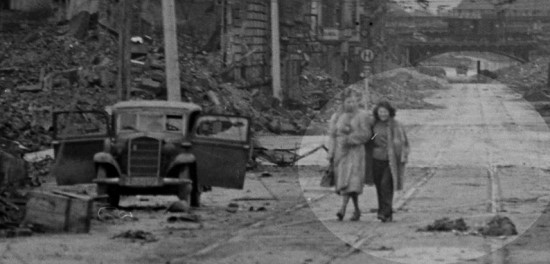
 source: John Florea - LIFE Photo Collection source: John Florea - LIFE Photo Collection
On a photo from the time when Katharina Esser is already not lying next to the car anymore, two civilian women are walking across Christophstraße. They are looking at the body parts on the street, where there are also boots. Maybe one of the women even happens to be the witness in question who later makes the affidavit ?

 Torn corpse parts with boots lay around on the street, here the corpse parts which the two women had looked at in the last picture. This may possibly have caused the witness then also to the purposeful explanation to mention especially the boots which Katharina Esser is supposed to have worn then. Presumably, the witness was asked how she would determine that the body remains found there would come from Esser. And presumably it was then simply up to the witness to mention that Esser had been wearing boots in order to be able to prove the death clearly from her point of view. Or maybe the police investigating the disappearance of Esser had even explicitly inquired or asked whether the body parts with the boots had been from Esser (just as Rheindorf had also asked in the first version of his film documentation whether the body parts could be from Esser). Torn corpse parts with boots lay around on the street, here the corpse parts which the two women had looked at in the last picture. This may possibly have caused the witness then also to the purposeful explanation to mention especially the boots which Katharina Esser is supposed to have worn then. Presumably, the witness was asked how she would determine that the body remains found there would come from Esser. And presumably it was then simply up to the witness to mention that Esser had been wearing boots in order to be able to prove the death clearly from her point of view. Or maybe the police investigating the disappearance of Esser had even explicitly inquired or asked whether the body parts with the boots had been from Esser (just as Rheindorf had also asked in the first version of his film documentation whether the body parts could be from Esser).
As the photos of the Esser lying on the ground show, she was lying very close to her car, the legs/feet were probably even under the car. It already does not seem comprehensible that the witness could then from some distant position even recognize what the Esser was wearing that day, especially the footwear:

 Feet / footwear are not recognizable even on the closer film images ... Feet / footwear are not recognizable even on the closer film images ...
In my view, these sentences in her affidavit in particular show that the witness in Christophstraße at the time did not in fact witness a great deal:
| " ... the owner was killed by a head shot and the employee, who was trying to look after her boss, whereby she was also shot at and fell down sideways next to the car. The employee was then run over by the tank so that afterwards only remains as well as hand, foot and some body remains were to be found ..."
|
How and where did Katharina Esser make an effort for her boss ?
That Esser lay motionless on the passenger side with her injuries is irrefutably established. This can be seen on the film pictures. But no tank could pass there because of lack of space and because of the house debris. The car and the car door were clearly undamaged when Florea took his photos in this street section and Esser was no longer lying there. So clearly there was no running over of the woman on the passenger side.
And crushed body remains (as WE know from the person from the other car) lay on the road after passing the American tanks on the driver's side of the car ...
Therefore, the alleged witness simply thought up a story about how she could coherently assign the body remains of the woman from the car. And there was only one possibility. The woman must have gotten out of the car and gone to the driver's side to "take care" of her boss. After all, the driver's door is open in Florea's later photos, and the boss is sitting dead in the driver's seat. The door open as if someone was looking after him. With a shot in the head, he could not have opened it himself.
And in this effort the woman was then shot and fell hit "sideways" next to the car. There she lay in the middle of the road and the tanks that subsequently drove across the road must have simply rolled over her in the process, turning the woman into the muddy remains of her body with boots on the road.
What the witness came up with, once visualized in this photo montage:
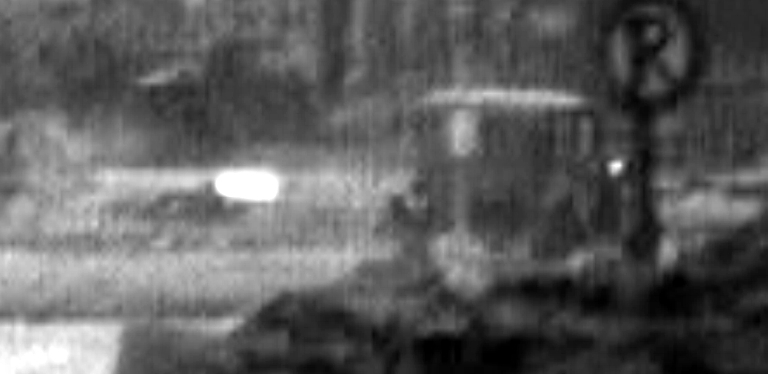
 Tank shoots at car - so far also reality ... Tank shoots at car - so far also reality ...
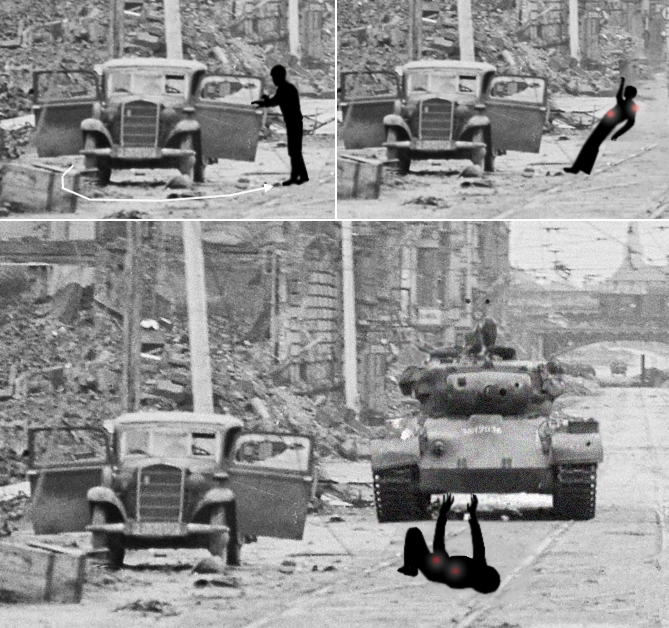
original source: John Florea - LIFE Photo Collection
 Woman runs around car, takes care of driver, gets shot, falls sideways next to car, gets run over by tank ... Woman runs around car, takes care of driver, gets shot, falls sideways next to car, gets run over by tank ...
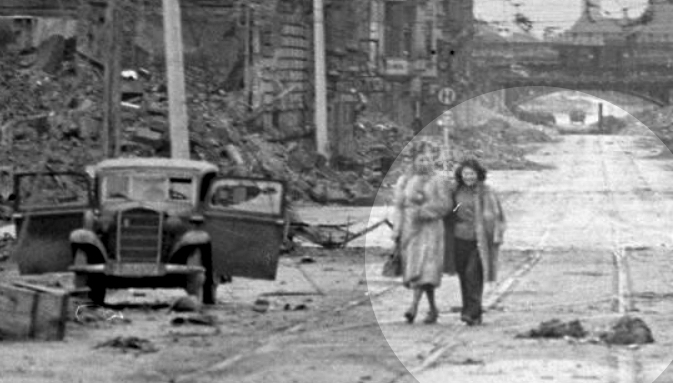
source: John Florea - LIFE Photo Collection
 After being run over by tanks, in the witness's conclusion, pieces of the woman's body are left lying on the road ... After being run over by tanks, in the witness's conclusion, pieces of the woman's body are left lying on the road ...
For the witness, this was probably the only plausible explanation for the situation she later found herself in and led to her affidavit.
But it clearly does not match the film images and photos of the American cameramen, which the witness almost certainly did not know at the time. There Esser lay just badly injured on the passenger side.
Thus, in reality it looked like this:
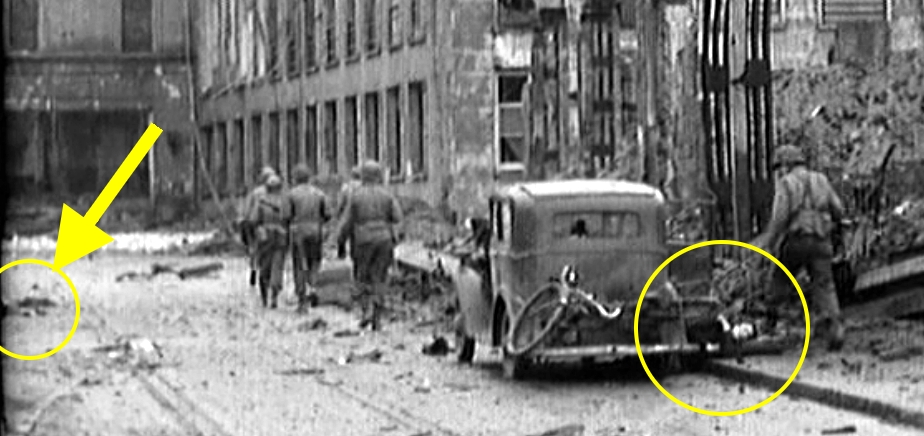
 Katharina Esser injured on passenger side, right circle, body parts from the occupant of the car on the other side of the road are already lying on the road at this time, arrow ... Katharina Esser injured on passenger side, right circle, body parts from the occupant of the car on the other side of the road are already lying on the road at this time, arrow ...
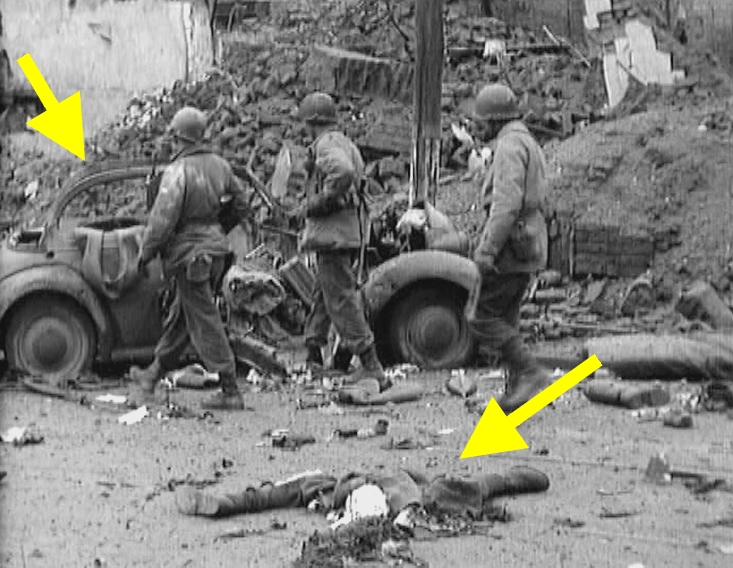
 The body parts, right arrow, from the occupant of the other car, left arrow ... The body parts, right arrow, from the occupant of the other car, left arrow ...
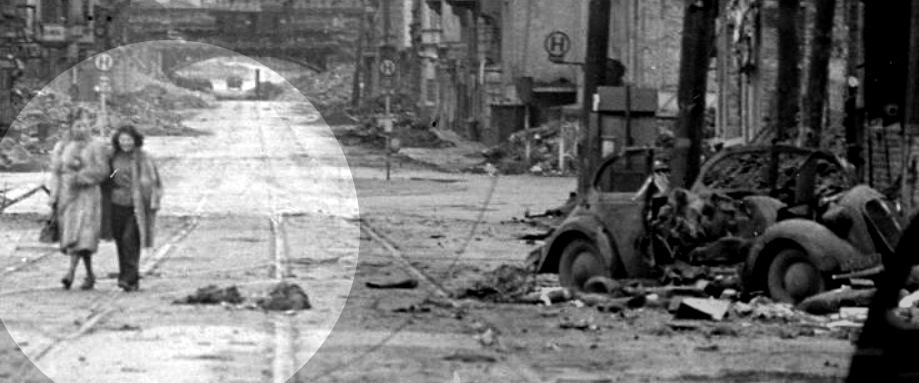
source: John Florea - LIFE Photo Collection
 Two women look at the body parts that are not Esser's, but from the other car's occupant on the right side... Two women look at the body parts that are not Esser's, but from the other car's occupant on the right side...
And the affidavit at the police also appears so dispassionate, that from my point of view it also does not result that this running over could have happened from a dangerous situation like a sudden firing by a bazooka. According to the witness, the woman fell "sideways" next to the car and was run over by "the tank" ... finished ...
Wow, it can hardly be shorter ...
Also strange: according to her statement she knew that Esser was an employee and the driver was her boss.
How should she be able to say that from her own, uninfluenced knowledge ? Obviously she did not know both persons at all and knew that they were employees and boss ? Esser and Delling did not live in this part of the city before.
This all speaks rather for the fact that appropriate messages were already made to her before, which then influenced or even steered her statement ...
Also she recognizes "the girl again" when giving the statement ...
How can that be ? Which photo was presented to her for recognition ? A family photo, a picture from the film scene of the US Signal Corps ? And with what was compared ? Did she really see the face of the woman who had fallen out of the car from a great distance ? Probably not ...
Then, in reality, she surely did not recognize the face at all and thus did not really identify the person. How then also: from a body, which consisted after the alleged running over by a tank only of "rest pieces as well as hand, foot as well as some body remains" ? There is no mention of a head in this enumeration either ...
So, this affidavit is really very curious. It seems that the Cologne police did not really want to do an extensive clarification. Presumably, the statement was more or less put into the witness's mouth in order to finally close the case. A tiresome procedure from wartime. Nicely resolved by the fact that the victim was simply run over and identified. No further elaborate investigations necessary ...
And what should also come out at the end of long investigations ? Who else should be held responsible for the death of Katharina Esser. The US Troops, the war winners ?
A quick, supposedly clear affidavit at the end of the investigation for the file, that's what the police wanted and that's what they got ...
Maybe the witness really did hear or see something on the morning of March 6. But it seems rather that it is more pure conclusions that she has drawn than something that really happened in this form. The overrunning of the person Katharina Esser by a tank she has certainly not really seen according to my conviction ...
Final consideration
What actually happened to Katharina Esser on that day after the last filming ?
As the only concrete written document on the subject of the death of Katharina Esser, there is only the affidavit of the witness.
The other allegations and alleged evidence which Rheindorf added to an overall picture he favored and which have been closely examined above, must be regarded as inaccurate or at least classified as extremely questionable.
It gives the impression that Rheindorf preferred to prove with all his might that Esser had been run over by a tank rather than "simply" having died from the injuries he had suffered. Of course, the story with the tank is easier to sell ...
However, according to the above, the affidavit is useless for clarification because it is not consistent and does not correctly reflect the actual events. It must be assumed that the witness did not actually know very much about what happened in Christophstraße and merely put together individual pieces of the puzzle as she saw fit or was guided by the police to a certain explanation.
The picture of John Florea, which he quite obviously took when the fighting units with the other cameramen had already moved on to the banking district, i.e. also at a point in time of which Rheindorf claims that the fighting on Christophstraße had sprouted again there and Esser had been run over, shows in my opinion best what actually still happened on Christophstraße that afternoon.
Once again: the photo was taken after the withdrawal of the cameramen who had filmed Esser still lying on the ground and who had moved on with the front combat units in the direction of the cathedral:
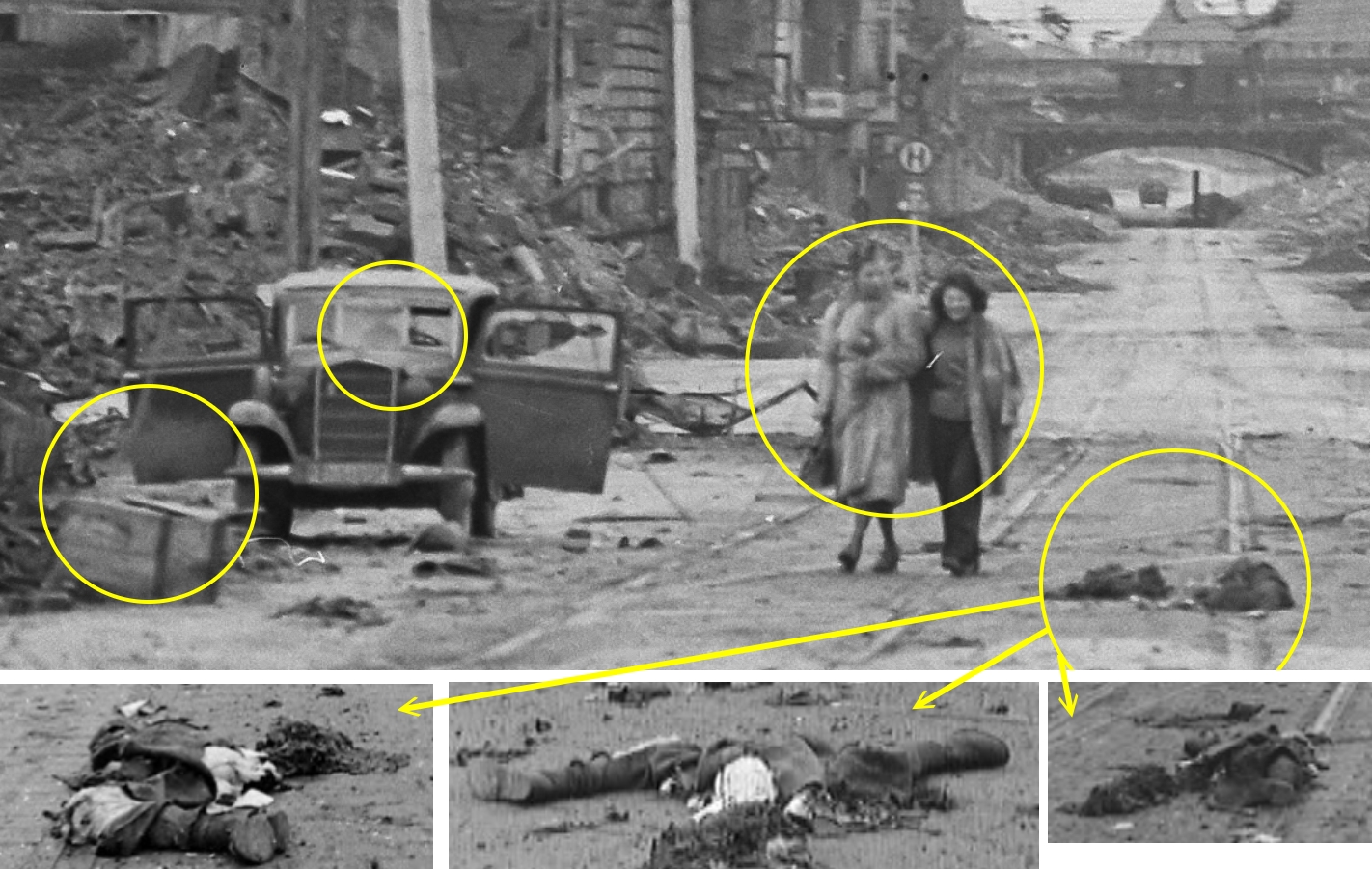
 source: John Florea - LIFE Photo Collection and NARA source: John Florea - LIFE Photo Collection and NARA
Four key findings in one photo:
1.) Esser is no longer lying next to the car.
2.) The driver Delling is still sitting dead on the driver's seat.
3.) Two civilian women in fur coat are walking leisurely along Christophstraße and at this moment they are looking at the crushed human torso lying in the middle of the street not far from Esser's car.
4.) And just the crushed human torso lying on the street. Under the big picture three smaller, different angles on this torso.
It is easy to imagine that one of the two women is actually the later witness (who lived there in Christophstraße). Clothing and the fact that they are walking slowly on the street leads to the assumption that they have their apartment in this area and "want to take a look" at what has happened in their environment after the passage of the US troops.
The torso gives the impression that a tank drove over it. If one know (from wherever) that there was also a woman sitting in the car next to the dead driver and that she is now no longer there, but next to the car with the open driver's door lies a torso wearing boots, an observer of the scene on the ground that morning can certainly draw the conclusion that the torso must be this woman.
However, we know from a close examination of all the film images that the torso was not Esser but a soldier from the destroyed other car in the intersection.
Together with the formulation in the affidavit that Esser still wanted to help the driver, then was hit by bullets and fell next to the car, where she was then run over by the tank, this results in an explanation for the formulations in the affidavit of the witness that is obvious from my point of view.
It sounds exactly like a short version, but it also fits exactly with the photo of John Florea.
In the dangerous situation of fighting US troops and the German tank at that time, the witness certainly did not notice very much of what happened in detail that morning.
But she probably knew already at that time or only through later information that there was still a woman in the car. From the things she then saw at the scene, it was not far to the conclusion in the affidavit.
Presumably, she simply concluded that Esser had gone to the driver's door to help the driver, then had been hit and had fallen down toward the road. After all, that would explain the torso being on the driver's side of the car.
There she was run over by a tank, so that only a crushed torso remained of her. And the torso wore recognizable boots, by which Esser then wants to have recognized her, among other things. The emphasis in the affidavit that the woman was wearing boots, the only thing still recognizable about the torso, thus becomes comprehensible.
In fact, however, this scenario did not exist.
Katharina Esser sat injured in the car next to the dead Delling for a long time, then lay on the passenger side next to the car for treatment and was then quite obviously already taken away when John Florea took his photos in the Christophstraße area.
The car was undamaged on the street when Florea's photos were taken - apart from the hits by bullets. No tank panicked by sudden fire had moved, destroyed, or run over it. The driver, however, was dead in the car. Except for the well-known crushed body of the occupant of the other car, no other human bodies are visible on Florea's photos (he took several shots there) on the road there near esser's car. Also no shot down US tank is to be seen there.
Knowing that dead civilians were still lying around everywhere in the city days later and that Delling was also still sitting dead in the car, but Esser was no longer lying next to it, this allows only one conclusion in my opinion:
Esser is no longer to be seen there, because she has been taken away.
And probably in a living state ! A dead Esser would - like many other dead civilians in the area, Delling included - probably still lie on the spot. In her case dead next to the car on the passenger side.
Initially, three people could be seen next to Esser in the film images:
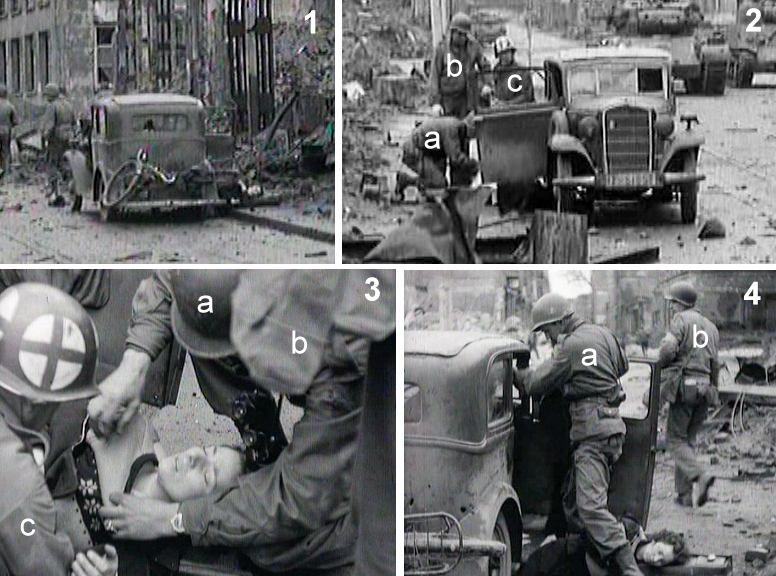
 Image 1: Esser lies on the ground before receiving his first medical treatment. Infantrymen walk by, unimpressed. Image 1: Esser lies on the ground before receiving his first medical treatment. Infantrymen walk by, unimpressed.
Picture 2: 3 people near Katharina Esser. Soldier a kneels next to her, a medic c and another soldier b with a large shoulder bag stand next to her.
Image 3: Medic c and soldier a kneel next to Esser. Soldier b is standing, visible at the right edge of the picture.
Image 4: Paramedic c is no longer visible, soldier b is just leaving and soldier a is still at the car to put a jacket over Katharina Esser's upper body.
The treatment seems to be completed as far as possible in these minutes.
The photos of John Florea, which were taken a little later, when the fighting units had already moved on towards the cathedral, show that there were more medics in the area and that they were even at Esser's car.
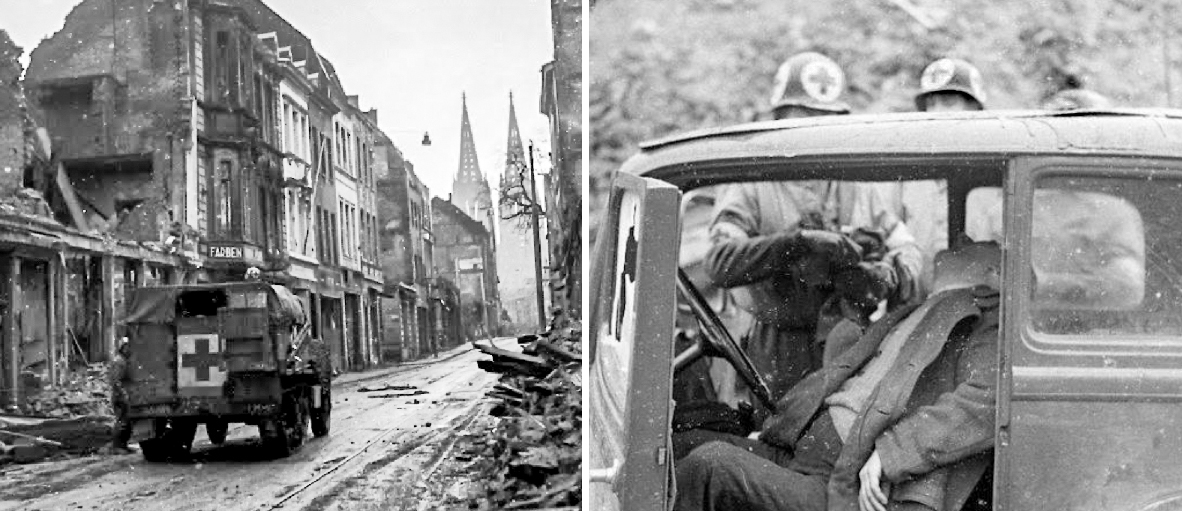
 image detail source: John Florea - LIFE Photo Collection image detail source: John Florea - LIFE Photo Collection
On the left you can see an M3 Ambulance Halftrack vehicle on Christophstraße and at the car of Katharina Esser there are 3 paramedics. However, Esser is no longer lying there at this moment, as the other pictures of Florea show, so she has already been transported away.

 source: Wikipedia / NARA source: Wikipedia / NARA
Photo of a M3 Ambulance Halftrack vehicle, which was intended for transporting injured people.
So that all speaks for a removal in living condition.
A single exception could conceivably be made for removal in a dead state.
She was a woman and if she died on the spot, maybe they didn't want to just leave her dead there on the sidewalk.
In addition, it is possible that even more paramedics or an ambulance had been called to the place to treat or transport away Esser and these then took a dead woman exceptionally also, because they were now already there and the woman was their concrete target. But this is pure speculation.
Thus, after all this, three findings remain on the subject of Katharina Esser.
1.) Esser was not run over by a tank, but she was taken away from the place Christophstraße.
2) Probably she was even transported away alive. But it can not be completely excluded that she already died on site and was then transported away.
3) Katharina Esser did not appear alive anywhere after that. As a result of the sworn statement of the witness, her death was officially established and a death certificate was issued.
More about Katharina Esser
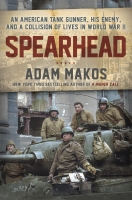 | Adam Makos, New York Times bestselling author of "A Higher Call", has written a book about Pershing's gunner, Clarence Smoyer and his experiences during World War 2. As part of the research, I was able to accompany Adam and Clarence on a visit to the original sites in Cologne, Germany. There he also met the gunner of a German tank, Gustav Schäfer, whom he had faced during the advance in Cologne. The image link leads to Amazon's website, where the book can be ordered. The book also deals with the events surrounding Katharina Esser. Clarence writes in it that the memories of the fate of Katharina Esser gave him many sleepless nights and nightmares. Until his death on 30.09.2022 at the age of 99 he could not forget the events of March 6, 1945...
|
|
What does the bestselling author Adam Makos actually say about the topic Katharina Esser and death by a tank rolling over her ? Rheindorf points out that Makos does not deal with this topic in his book ...
On his website, Makos comments on Rheindorf's theory (trojan tank is another theory of Rheindorf concerning the topic tank duel at the cathedral which is not further discussed here on this subpage):
| | "There are some discrepancies between our research and the stories presented in these films. Notably, we reject the theory of a "trojan tank" and the theory that Kathi Esser was run over by an American tank. Both are a case of mistaken identity.
In regards to Kathi, even before Delling's car drove into the crossfire, there was a second German car wrecked in the intersection and laying nearby were the legs of a dead German soldier—upper torso missing—and still wearing boots. You can see this in the film.
Following the battle and after Kathi's body was removed, an elderly German woman reported that Kathi—who had been lying beside her car—was gone and she had been run over by a tank! Her proof? There was just a pair of legs laying in the street nearby, still wearing boots. She was describing the legs of the dead German soldier."
|
Thus, Makos also does not believe that Katharina Esser was run over by a tank, but sees only the wrong interpretation of the body remains with boots on the street by the witness as the cause of the affidavit made in this way. Since for Makos - as for me also - it is clear that the theory with the overrunning tank cannot be true and Rheindorf is the only one who has put forward this theory, he saw no reason to include it in his book. Makos deals with facts and not with crazy theories ...
|
.
The link below to the main page on the subject of tank duel with many other subpages.
|